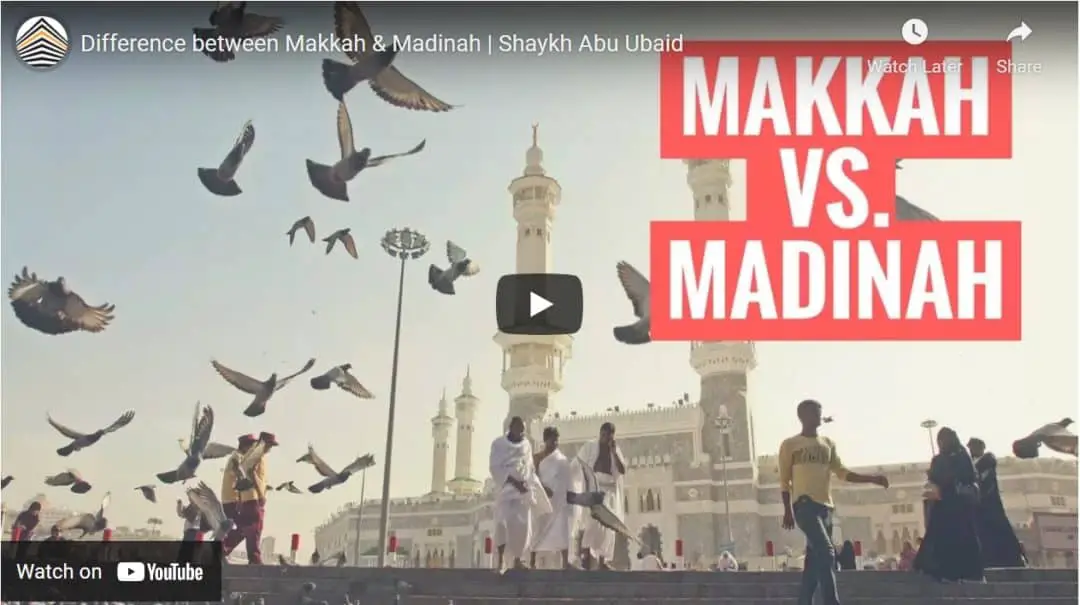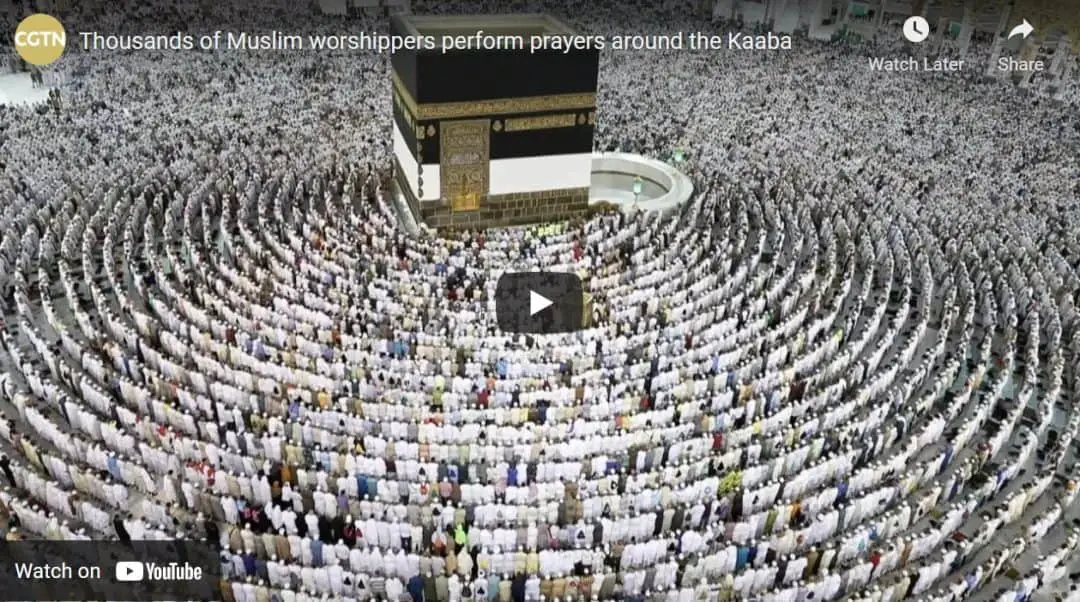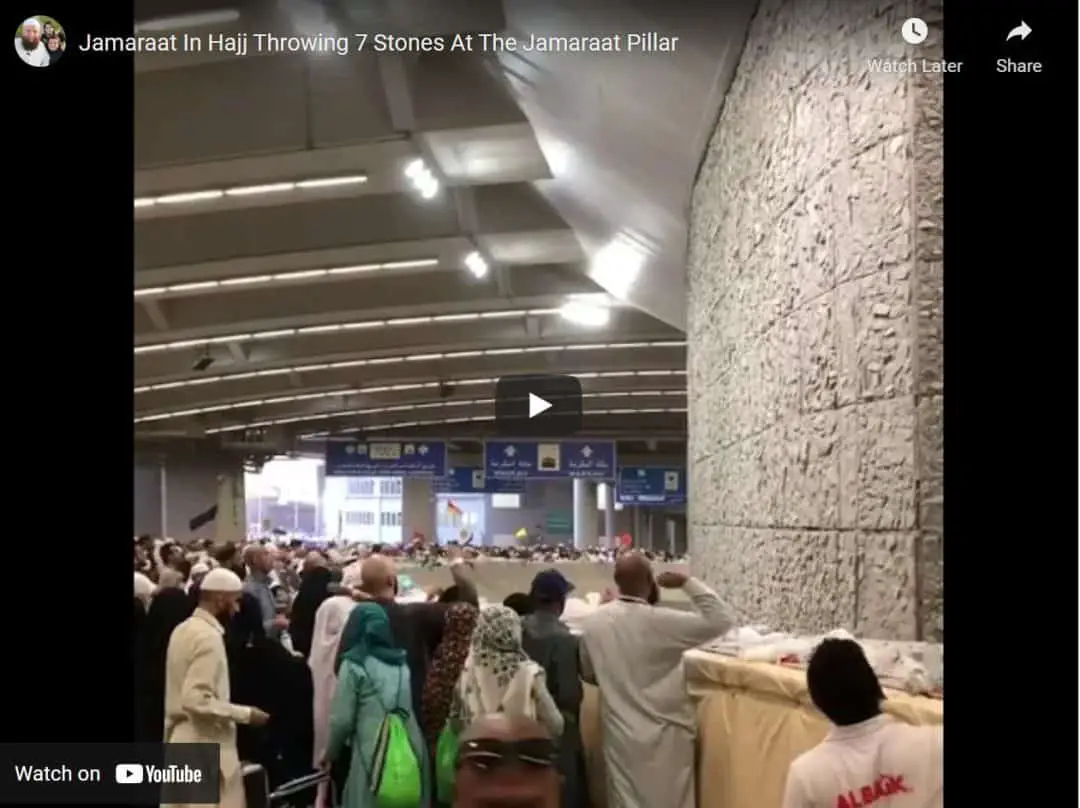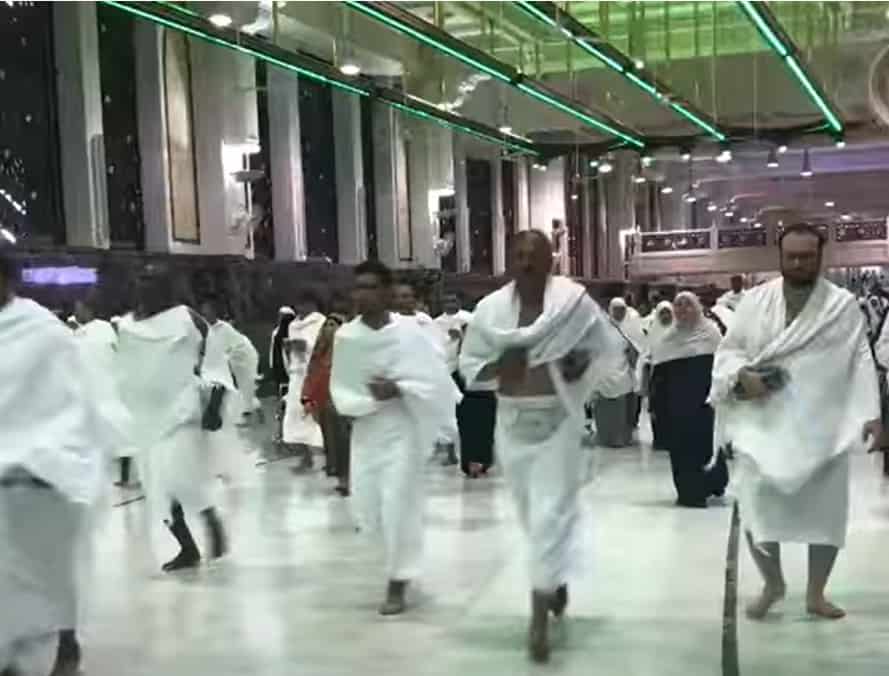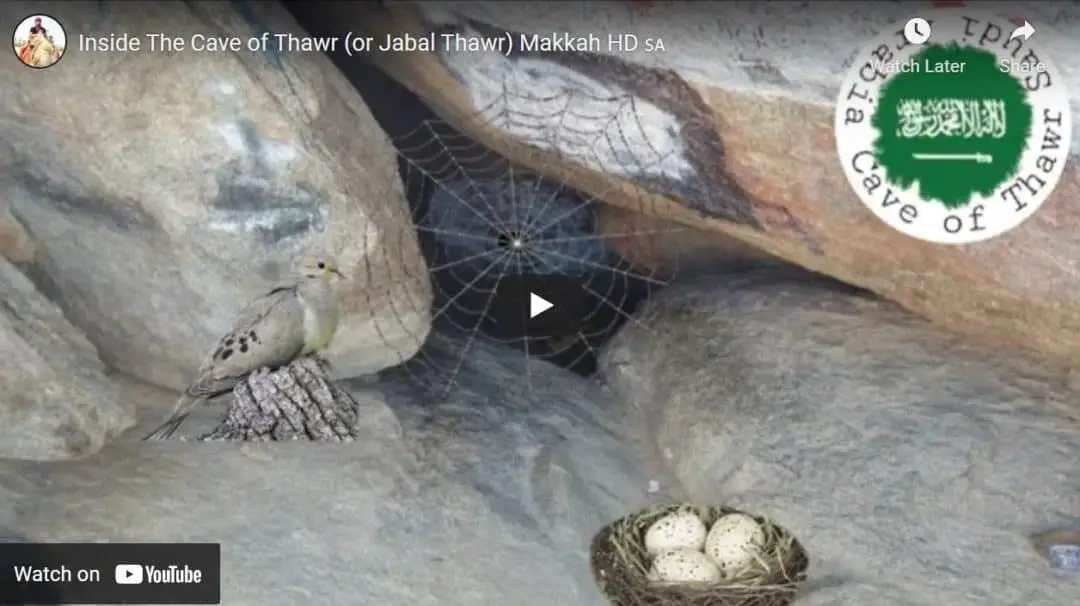I was puzzled when during Hajj in 2006, the organizers took all Muslim pilgrims (Hujaj) in our group for an additional two day trip to the city of Madinah. I know Mecca and Madinah are the two most important cities in Islam with Jerusalem as the third. However, I did not know why.
So, I decided to research the subject to find out what the differences really are and why both cities are so important to Muslims
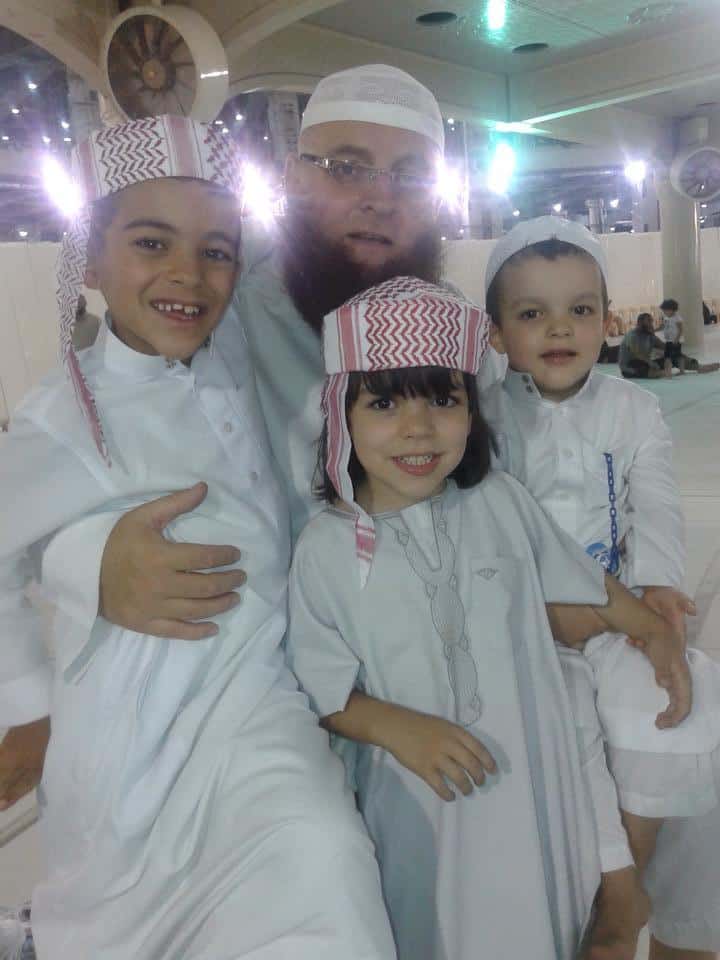
So for Muslims, what is the difference between Mecca and Madina? Mecca is blessed with Hajj/Umrah, the Kaaba, Black Stone and prayers at the Haram Mosque having the rewards of 100,000. Madina (425 km away) has three important mosques, Al Nabawi, (rewards of 500 prayers), Al Quba (1st Mosque in Islam) and Al Qiblatayn (Two Qiblas) and where pilgrims get close to graves of Prophet Mohammed (SAW), his family and companions, the Sahaba.
Every year, up to 15 million Muslim pilgrims have the great honor of performing Hajj or Umrah and visiting the two cities where Prophet Mohammed (SAW) himself was born (570 CE), was raised, where he received the Quranic revelations, where he established Islam and where finally he passed away (632 CE) 1,400 years ago.
In addition to the wonderful facilities both cities offer to assist in the fulfillment of Islamic rites and duties, they also contain an array of religious and historically important sites that help Muslim pilgrims increase and strengthen their religious faith (Iman).
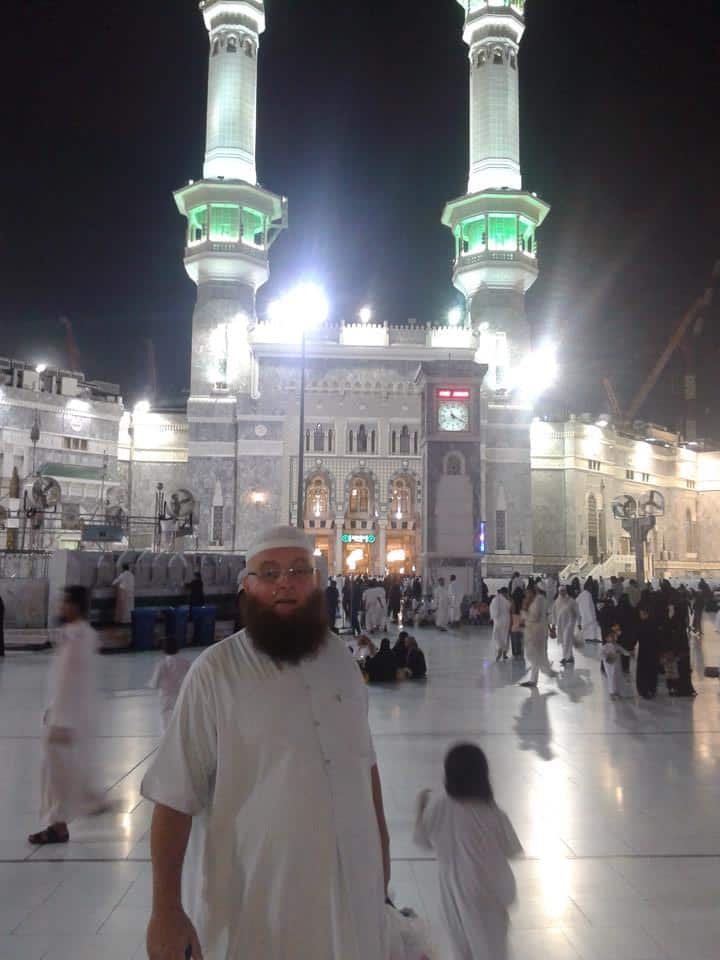
Mecca
One prayer offered in Masjid Al Haram, Mecca has 100,000 rewards more than in a normal mosque. One prayer in Masjid Al Nabawi is better than 1000 prayers offered elsewhere.
Also, Mecca is a sanctuary for Muslims, a safe haven where even trees, plants and animals must not be killed. That is not the case in Madinah.
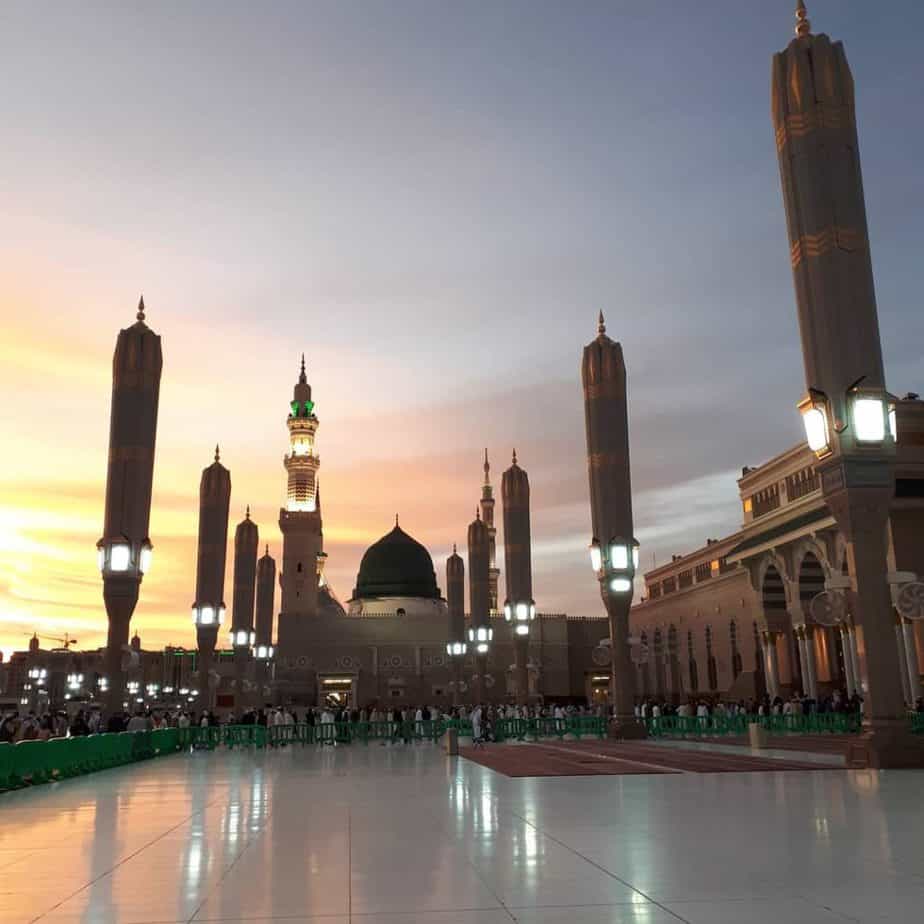
Madina
On the other hand. Madina is the city where Prophet Mohammed (SAW) and some of the early Muslims migrated (Hijrah) in 622 CE and the place where the Muhajireen and the Ansaar (locals) helpers joined together.
It is the city from where Jihad was waged against shirk and false beliefs. It is the city where Prophet Mohammed (SAW) returned and finally died in 632 CE.
Muslims want to go to Madinah either to live or to visit with a deep longing to see the Messenger of Allah (SAW), his family, the rightly guided Caliphs, the Sahaabah, the scholars and the beautiful people of that city.
Madina Al Munawara is also special to pilgrims because it is the site of the Quba Mosque the first mosque in Islam built by Prophet Mohammed (SAW) himself and by his companions and in which the Prophet (SAW) offered two Rakaat prayers each and every Saturday.
Also, it has the Masjid Al Qiblatayn mosque that contains two prayer niches (Mihrab), one for Mecca and one for Al Quds in Jerusalem.
This is the mosque where the early Muslims changed the direction (Qiblah) of the 5 daily prayers towards Mecca after Prophet Mohammed (SAW) had received the revelation from Allah to change it away from Jerusalem.
| Facts | Mecca/Makkah…….. | Medina/Madinah |
| Region | West Hejazi Capital | West-Al-Madinah Hejazi |
| Mosques | Haram | Al Nabawi Al Quba Al Qiblatayn |
| Prophet Mohammed (SAW) | Born 570 CE | Death 632 CE (Aged 62) |
| Holiest City | 1st | 2nd |
| Known For | Hajj/Umrah Kaaba Black Stone | Hijrah 622 CE / 1 AH Old Muslim Capital Grave Prophet Mohammed (SAW) |
| Population | 2 million + 5,000 Plus Hajj 2.5 million | 1 million + 300,000 |
| Historical Population | Ibrahim (Hajar/Ismael) Al Quraysh Bani Kinanah/Khuza’a /Hudhayl Banu Tamim | Jews Bani Qaynuqa/Qurayza/Nadir Arabs Bani Aws/Khazraj Muhajirun -Immigrants Ansar -Helpers |
| Historical Employment | Merchants/Traders | |
| Historical Names | Bakkah Mecca Makkah (Official) Makkah Al Mukarramah Um Al Qurah Tihamah Faran/Pharan (Hills) | Yathrib Tayba Madinat Un Nabi Madinat Un Al Munawarah |
| Distance | 338 km (A to B ) 210 m | 425 km (Road) 264 m |
| Distance From Red Sea | 67 km (A to B) | 140 km (A to B) |
| Location | Narrow Valley 277m above sea 909 ft | Oasis In Hills 625 m above sea 2,050 ft |
| Graves | Jannat al-Mu’alla Abu Talib Ali Abd Manaf Abdul Muttalib Khadija and Children Abu Turab Al Zahiri Muhammad Al Alawi Al Maliki Kh Maimoen Zubair | Prophet Muhammed (SAW) Jannat Al Baqi Cemetry Fatimah Hassan Aisha Umar Ibn Al Khattab |
| Campaigns | Mecca 629 CE-8 Ah | Al-Badr 623 CE-2AH Al-Uhud 624/5 CE-3 AH AlKhandaq 627 CE-5 AH |
| Caliphs | Abu Bakr (632-634 ) Umar (634–644 ) Uthman (644–656 ) Ali Kufa-Iraq (656-661) | Abu Bakr (632-634 CE) Umar (634–644 CE) Uthman (644–656 CE) Ali (Kufa-Iraq) (656-661)) |
| Other Rulers | Hashemite Sharifs Sayyid Bin Hussein Al Saud 1925 | Mamluks (13th C) Ottoman (15th C) Al Saud 1925 |
| Only Muslims | All Mecca | Madinah Haram Area |
| Religious Features | Haram Mosque Kaaba Abraham Station Safa & Marwa Mina Muzdalifah Jamaraat Arafat | Tombs Amr Bin Al Aas Aaron Al Rimah (Hamza & Co) Hazrat Aisha Prophet’s Minbar |
| Archeological | Ajyad Fortress Jabal Al Noor Cave of Hira Jabal Al Sawr Cave Thawr (web) | Mount Uhud Hazrat Hamza City Wall Bab Al Salam Riyadh Al Jennah |
| Modern Features | Abraj Al Beit Mecca Clock | |
Events | Quran Revelations 610 Muslims Enter Mecca 630 Idols Destroyed | |
| Quranic Surahs Revealed | 86 | 28 |
Mecca- Main Activities For Pilgrims
- Prayers in The Haram Mosque
- Circumambulating the Kaaba (Tawaf)
- Kissing Black Stone (Hajr Aswad)
- Drinking Refreshing Zam Zam Water
- Performing Hajj (Staying at Mina, Muzdalifah & Arafat)
- Killing Satan at the Jammaraat (Rami)
- Performing Umrah
- Running Safa-Marwa
- Being With Muslims only
Mecca-Additional Activities
- Visiting the Zam Zam Water Bottling Plant, Kudai
- Seeing Hubal
- Visiting The Old Ajyad Fortress
- Going to Jabal Noor
- Entering The Cave of Hijra
- Entering The Cave Thawr
- Shopping in The Abraj Mecca Tower
- Going to the Top of the Mecca Clock
Madinah Al Munawara- Main Activities For Pilgrims
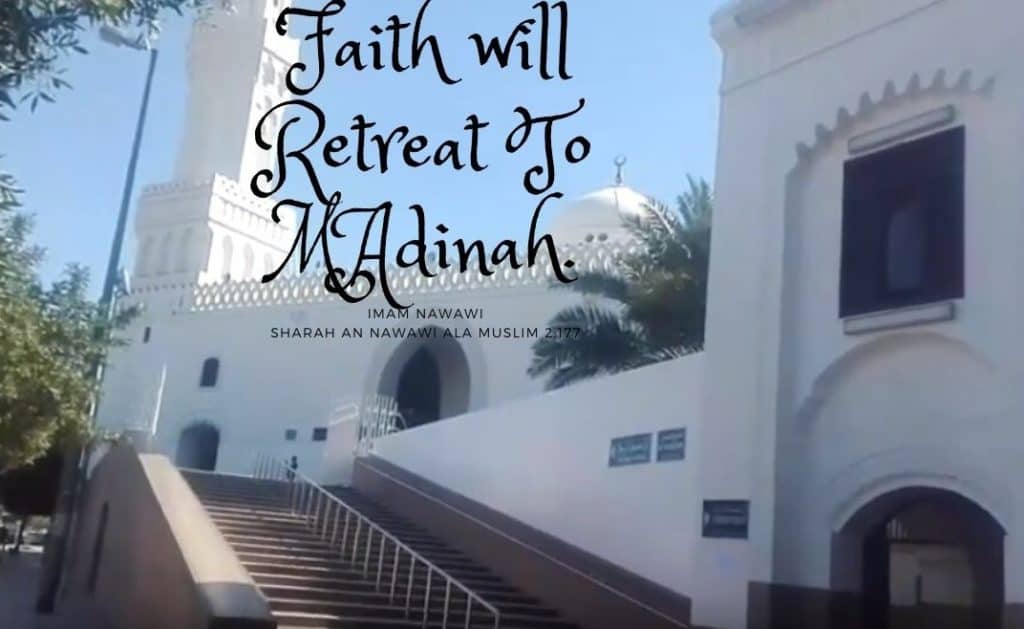
- Praying at Masjid Al Nabawi
- Praying at Quba Mosque
- Praying at Qiblatain Mosque
- Visiting Tombs
- Jannat Al Baqi
- Making Salams to Prophet Mohammed (SAW)
- To Fatimah (RA)
- To Hassan (RA)
- To Aisha (RA)
- To Abu Bakr (RA)
- To Umar Ibn Al Khattab (RA)
Madina Al Munawara- Additional Activities
- Visit The Badr Battle Site
- Visit The Uhud Battle Site
- Grave of Hamza and Martyrs (RA)
- Visit The Trenches Battle Site (Khandaq)
However, what Muslim pilgrims (Hujaj) are able to see and do in Mecca and Madina from the above list depends largely on their itinerary, length of stay and physical capacity. Some of the activities above are easy and straightforward.
Others require time, a greater level of interest, effort, patience, and stamina.
Main Activities In Mecca For Pilgrims
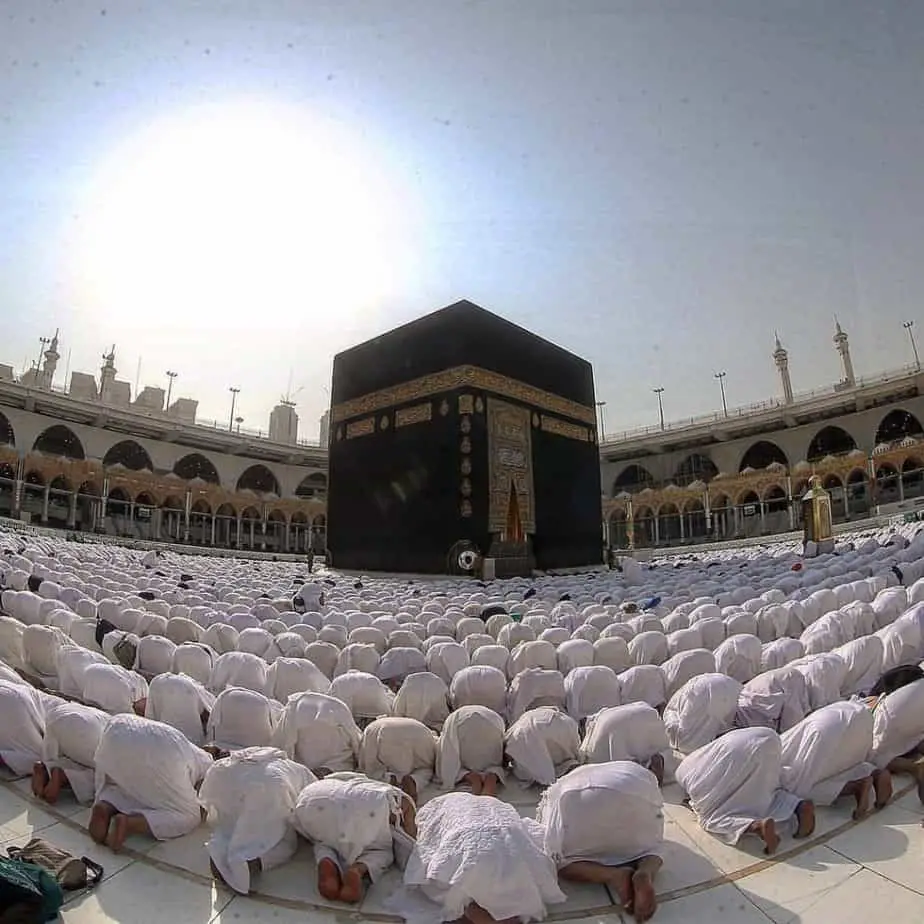
Praying In The Haram Mosque
The Masjid Al-Haram mosque is the largest in the world and the holiest mosque in Islam. It encircles the Kabba and has four levels. Today, it can hold 2.5 million pilgrims. It is carpeted, air-conditioned, well supplied with Zam Zam water and is cleaned and polished every day.
It contains the Kaaba at the center, the Zam Zam Well, the Black Stone Hajraswad. Ibrahim’s Station, (Maqam) and three levels reaching the hills of Safa and Marwa.
Masjid Al Haram has been constantly under renovation since the year 692 CE beginning in the Umayyad era 693 CE, then in the Ottoman period in 1517 and 1929. From 1955 to 1973 onwards further expansions were made by the then Saudi kings.
Also, a new wing and outdoor prayer area were added in between 1982 and 1988 under King Fahd. Further expansions occurred between 1988 to 2005 to include minarets, domes, 18 new gates, and a further 500 columns. It now has 11 minarets.
Massive expansion occurred again by King Abdul Aziz in 2008 covering an area of 300,00 m2, again by King Abdullah in 2011 to cover an additional 400,00 m2 and the latest by King Salman in 2015 to cover 450,000 m2.
Fun Fact
Telephone Handsets are placed at the main gate foyer entrances with a direct line to one of many Shaykhs to answer questions about Islam and Hajj and Umrah. For the same reason, they also meet pilgrims in their offices which are located throughout the interior of the mosque.
The Reward For Prayers In Masjid Al Haram
Muslims pilgrims often comment that offering prayers in Masjid Al Haram have 100,000 more rewards than prayers offered in any other normal mosque.
This is based on a hadith of the Prophet (SAW) that says:
In which parts of the Haram Mosque, these blessings apply is debated. Some scholars maintain it is the inside of the mosque only. Others say it means both the Mosque and the entire outside space considered to be the wider Haram area.
The correct view it seems is that the multiple rewards for prayers are those that are offered inside the Haram mosque itself.
This view is based on the hadith that Ibn Abbas (RA) reported that:
Prophet
Circumambulating The Kaaba (Tawaf)
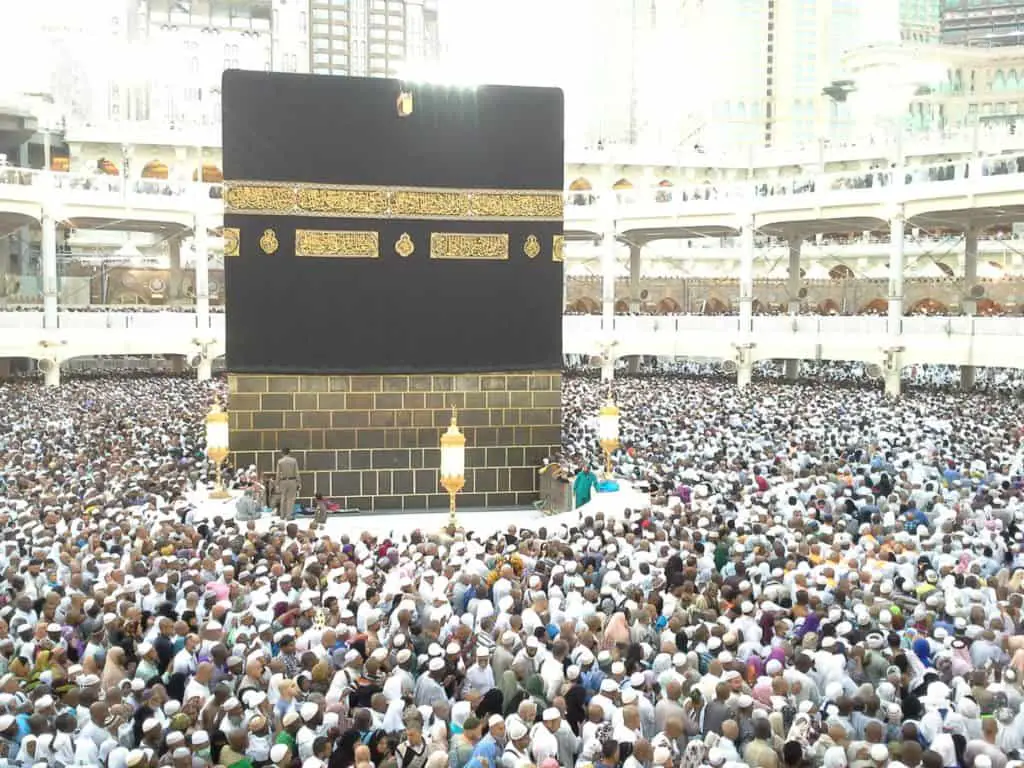
Going around the Kaaba seven times in a circular, anticlockwise direction is a very powerful act. It often reduces me to tears.
It is not an act of veneration or worship, rather it symbolizes in the pilgrims’ hearts that we move together as one, in one direction and emphasizes that there is only one true God Allah (SWT) truly worthy of worship.
It is an act designed to unite all 1.9 billion Muslims worldwide in the true worship of Allah (SWT).
Just as the electrons move around a nucleus, blood around the body, the moon around the earth, the earth around the sun, the planets around the solar system and galaxies around the whole of space in a counter-clockwise direction, moving around the Kabba seven times pilgrims symbolically unite with these elements as a demonstration of unity and praise of Allah (SWT).
Also, Muslim pilgrims do Tawaf because after making Hajj Prophet Mohammed (SAW) said to his companions:
Fun Fact
The Ihram towel covers the left shoulder during Tawaf and both shoulders in Sa’ee.
For more detail about Tawaf click and read the insidesaudi.com article about Why Muslims Walk Around The Kaaba Seen Times .
.
Kissing The Black Stone (Al Hajr Aswad)

At the Kaaba site (Mataf) pilgrims clamor, elbow and roughly jostle to kiss the Black Stone (Al Hajr Aswad). It is an astounding sight not meant for the faint of heart.
The stone was sent by an Angel Jibreel to Ibrahim who placed it in the eastern corner of the Kaaba. Also, it was the custom of our beloved Prophet Mohammed (SAW) to touch and kiss it.
PIlgrims also believe that on Judgement Day the Black Stone will have two eyes and a tongue to intercede and to speak for those (Muslims) who had touched the stone with sincerity.
Fun Fact: In the year 930 by the Qaramatian, Abu Tahrir Al Jannabi. He placed it in a mosque in the East of Saudi Arabia called Masjid Al Dirar so as to redirect the Hajj.
He failed and was reported to have been eaten by worms until he died a miserable death. The Black Stone was returned 23 years later in 952.
For more detail about Kissing the Black Stone click and read the insidesaudi.com article about Why Do Muslims Kiss The Black Stone In Mecca .
.
Drinking Refreshing Zam Zam Water
The miraculous Zam Zam well lies 21m, away from the eastern corner of the Kabba and is set 31 m deep under the ground.
It contains pure, clean and slightly sweet tasting water. It takes one pump 1 second to draw up1 liter a distance of 18.5m.
The mosque has two giant pumps. 700,000 liters of Zam Zam are drunk daily in the mosque, 2,000,000 liters during Hajj and peak seasons.

The well contains no bacteria, algae or plant growth. It is perfectly clean.
Its origins are divine and the first well was opened by Angel Jibreel (AS) who slapped his massive wing n the earth causing gushing water to emerge.
After it is pumped out, Zam Zam is filtered by UV light, bottled and sold. Rainwater replenishes the well.
It contains a number of essential minerals including calcium, magnesium, ferromagnesium compounds sodium and potassium chloride.
Prophet Mohammed (SAW) spoke about its benefits in the following hadith.
This means that if you drink Zam Zam to satisfy your thirst, it will be satisfied. If it is for health, it will make you healthy.
If you drink Zam Zam to relieve sickness, you will get well. If you drink it to fulfill a hope or desire then, this wish will be fulfilled.
Zam Zam water will work for whatever you intend it to do by the will and power of Allah (SWT). It can also can cure a large number of diseases and even increase your life span.
Fun Fact
Zam Zam Water contains a high level of arsenic. See article below.
For more detail about the greatest miracles of Zam Zam water click and read the insidesaudi.com article on Zam Zam Water 20 Compelling Reasons Why I Won’t Drink Normal Water Again.
Performing Hajj (Staying at Mina, Muzdalifah & Arafat)
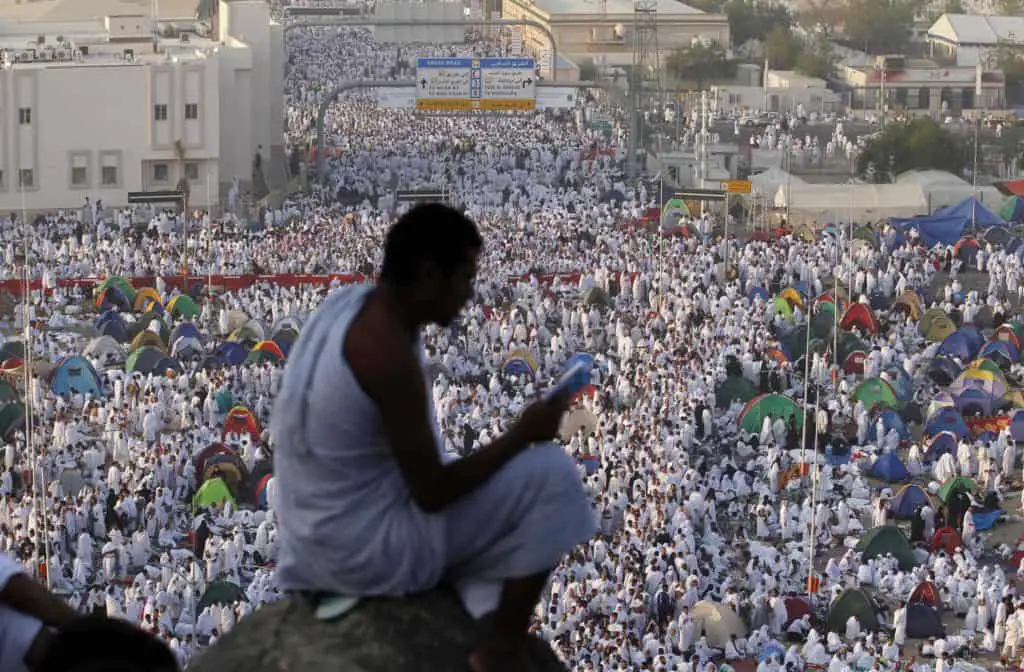
Every Muslim knows that the Hajj is a religious duty and that all Muslims MUST perform provided that they are able, physically and financially. It is the fifth pillar of Islam.
Each year, in the Islamic month of Duhul Al Hijah (8th-12th), 2.5 million pilgrims descend on Mecca to perform the rites. It is an ancient tradition predating the time of Prophet Mohammed (SAW).
Men dress in Ihram, a set of 2 unsewn white cotton towels, women in a light Abaya cloaks and hijab (no niqaabs allowed).
Day One
They start (8th) by first performing Tawaf, kissing the Black Stone if possible then do Sa’ee running between Safa and Marwa. Later (8th), they spend a day and night in Mina and attend the Friday Prayer.
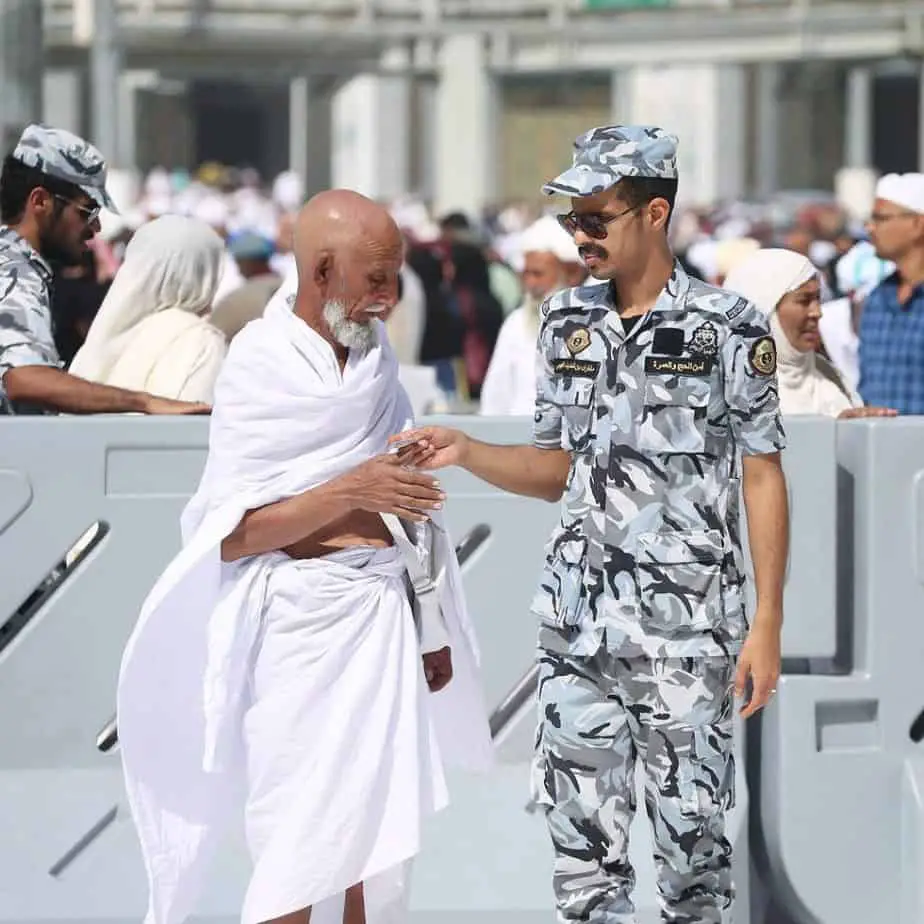
Day Two
On the Day of Arafat (9th) or Hajj Day, pilgrims walk or bus it to the plains of Arafat, listen to the Jabal Al Rahma sermon on the radio or by Smartphone internet.
This is where Prophet Mohammed (SAW) delivered his last sermon.
They stand before Allah (Wuquf) offering prayers, repentance and seeking Allah’s mercy.
On this Day TV satellite stations broadcast scenes of multitudes of pilgrims climbing Mount Arafat offering prayers and dua.
The noon prayer is offered at Al Masjid Al Namirah.
On the same day (9th) pilgrims head for Muzdalifah, pray Magrib and Isha prayers and spend the night praying or sleeping on the open ground before gathering up 7 pebbles for the ritual stoning of Satan at the Jamarat the next day.
Day Three
Killing Satan at the Jammaraat (Rami) With Stones
The Day of Rami (10th) is the day of throwing stones symbolically at Satan against the Jamarat (pillar) of Aqabah.
Today, to ease the flow of crowd traffic a multi-leveled bridge directs the pilgrims to the Jamarat pillar where they can throw 7 stones without getting injured or dying in a crush as occurred many times in the past.
To end the Hajj, an animal such as sheep or cow can be slaughtered, the hair can be cut or shaved and pilgrims revisit the Haram Mosque to make a Tawaf called Al Fadah.
Days Four, Five and Six
These are the days of Eid Al Adha (11th, 12th and 13th) meant for celebration and for further ritual stoning if necessary. Before leaving Mecca on the last day, pilgrims perform a farewell Tawaf called Al Wadaa.
It is a crowded difficult affair and better of you avoid the Kabba area do it on the upper floors.
Fun Fact
No one is allowed to enter Mecca during Hajj season except Mecca residents, Hajj permit holders and service workers.
From here the pilgrims head for Madinah to pray at Masjid Al Nabawi, the Quba Mosque, and The Masjid Al Qiblatayn.
Performing Umrah

Each year, more than 10 million pilgrims come to Mecca just to make Umrah. It is called the lesser pilgrimage.
As arriving pilgrims reach the Miqat area by plane or overland, they wash (Wudhu) or shower, make intention and wear the Ihram.
Umrah consists of Tawaf, (7 times) praying two Raqat prayers behind Ibrahim’s (Maqat) station, drinking and washing with Zam Zam water before making seven circuits of Saée between Safa and Marwa.
The Umrah ends by shaving or cutting hair (Halq) and then taking a shower before returning to wear normal clothes again.
It usually takes 2-3 hours to perform Umrah depending on the crowds and the time of day.
Fun Fact
Free toilets and hot showers are located underground outside the Masjid Al Haram. Wheelchairs can be rented free of charge if you deposit some form of ID.
To read more about the origins and later rediscovery of the Zam Zam well click and read the insidesaudi.com article on Zam Zam Water 20 Compelling Reasons Why I Won’t Drink Normal Water Again.
Running Between Safa & Marwa
During Hajj and Umrah, pilgrims run seven times between two hills of Safa and Marwa located in the Masjid Al Haram.
It one of the rituals in Islam to commemorate the movements of Prophet Ibrahim’s (AS) wife Hajr as she sought a water supply and provisions for her son Ismael.
She also ran up the hills so as to see her son down in the Mecca valley. She ran continually between the two hills until one day, Angel Jibreel (AS) opened up the Zam Zam spring from which freshwater sprang forth.
Thereafter, she was able to drink and breastfeed her son.
To read more about the origins and later rediscovery of the Zam Zam well click and read the insidesaudi.com article on Zam Zam Water 20 Compelling Reasons Why I Won’t Drink Normal Water Again.
Fun Fact
The marbled floor between Safa and Marwa is very slippy and difficult to traverse. Use a small wet cloth with Zam Zam and wipe your soles for a better grip or wear grippy soled socks.
Also, outside the Marwa exit door, there are barbershops. They are expensive, do a poor job and are not especially clean. Take your own scissors or cutting machine.
Only Being With Muslims
Unless they find a way to sneak into the Haram Mosque area of Mecca, everyone you meet in Mecca will only be a Muslim. Some people take exception to that fact and Muslims themselves often feel at a loss to explain why.
Islam prohibits non-Muslims from ever entering the Haram Mosque and it is based on a Quranic injunction (9:28).
The overriding goals are to prevent overcrowding, maintain peace, security and to provide sanctity for the millions of Muslims worldwide who live and visit there.
To read in more detail about the origins of this prohibition and reasons why Mecca is closed to non-Muslims click and read the insidesaudi.com article on Why Are Non-Muslims Not Allowed Into The Cities Of Mecca And Madinah?
Fun Fact
Non-Muslims are considered unclean due to their wrong beliefs NOT because they are intrinsically unclean or that they do not wash.
Additional Activities In Mecca For Muslims
Going to Jabal Noor And Entering The Cave of Hira
Jabal Noor or Mountain of Light lies 5km west of the Haram Mosque. It is 642m high and offers an outstanding view of Mecca and the surrounding area.
More importantly, the mountain contains the Cave of Hira (Ghar Al Hira) at 270m elevation where Prophet Mohammed (SAW) spent a lot of time in seclusion, meditation and prayer for one month each year.
The cave is small (3. meters deep and 1.6 m wide) and will comfortably sit only five people.
It was also the spot where in 610 CE he received the first revelation (Wahy) of the Quran on the night of power by Angel Jibreel Surah Al Alaq verses 1:5. Click the link  to hear it.
to hear it.
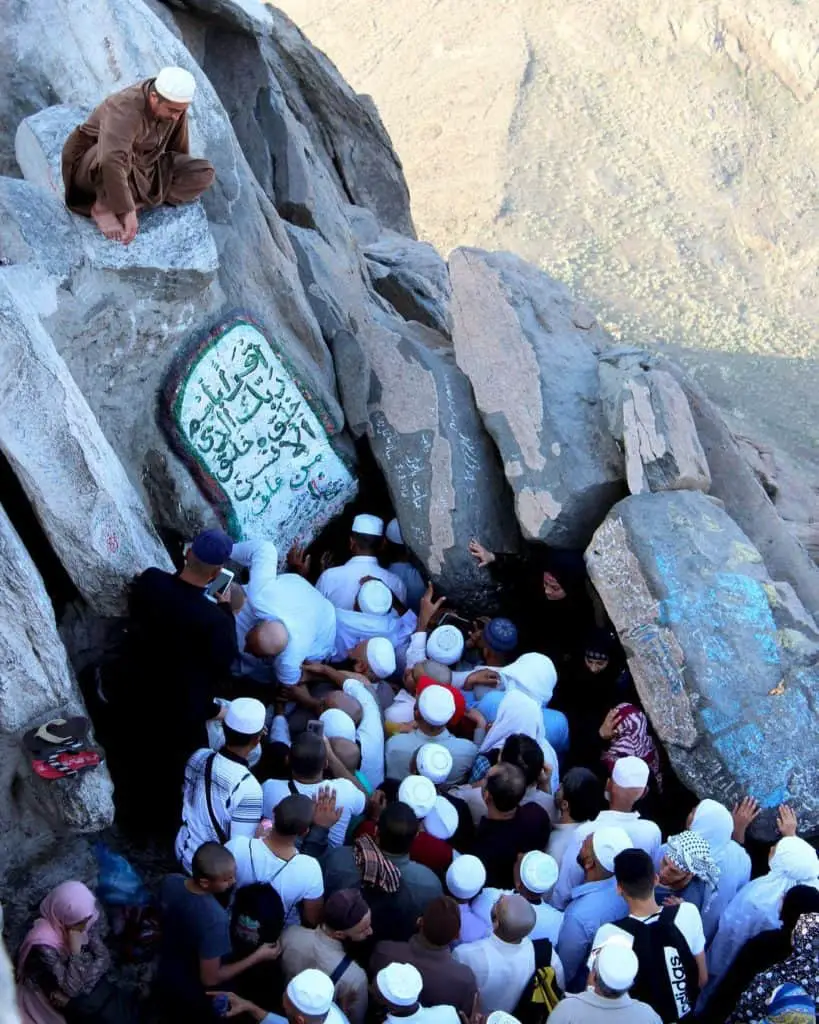
It is a very popular attraction for pilgrims making Hajj or Umrah. There are 1750 steps to the top. It can take 25 to 1:30 minutes to make the difficult climb. Many people struggle to walk up and need lots of rest.
There is a large car park partway down the mountain with food stalls and guides. As you climb, you find people selling dates, water and prayer beads.
Negotiate a taxi ride to Jabal Noor from the Haram mosque for SR30. It will cost you more to get a taxi back due to the demand. The whole trip will take 3-4 hours.
There are usually lots of visitors and the weather can get very hot. Sadly, the site gets strewn with rubbish and is not well maintained. Plans are afoot to upgrade the site.
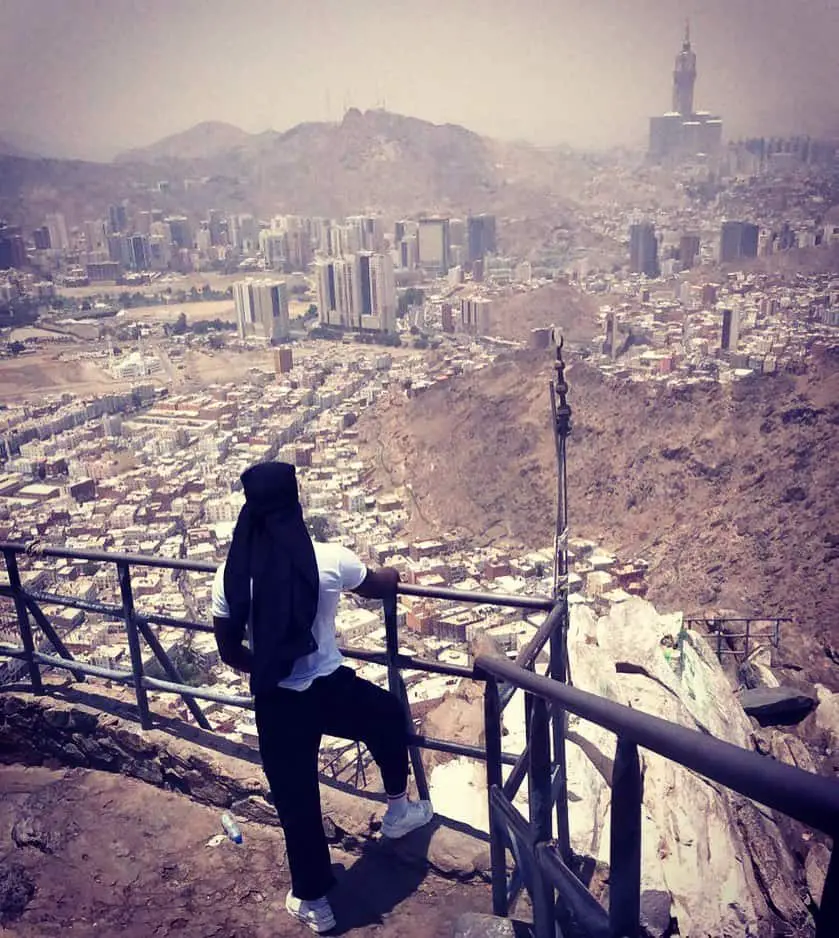
Fun Fact
The best time to visit is early morning after Fajr before the sun rises. There are almost no people and the weather is cooler.
If you go in the daytime, take an umbrella and lots of refreshments.
Click here to read a Wikipedia entry about Jabal Noor. 
Climbing Up Jabal Thawr
Jabal Thawr is a mountain in Mecca. It stands at 1,405m or 4,610 ft high. Prophet Mohammed (SAW) and Abu Bakr took refuge in a cave there for three days and nights from a Quraysh search party after setting off on the road to Madinah (Hijrah).
To protect them both, Allah set up a spider’s web in the doorway to the cave and a nest of doves in a tree close by. This caused the Quraysh search [arty to assume that no one had entered the cave and that it did not need searching.
The cave itself is located at the top of the mountain. It commands a great view of Mecca and the surrounding area.
There are two ways to access it. There is an Eastern entrance and another very narrow entrance from the Westside.
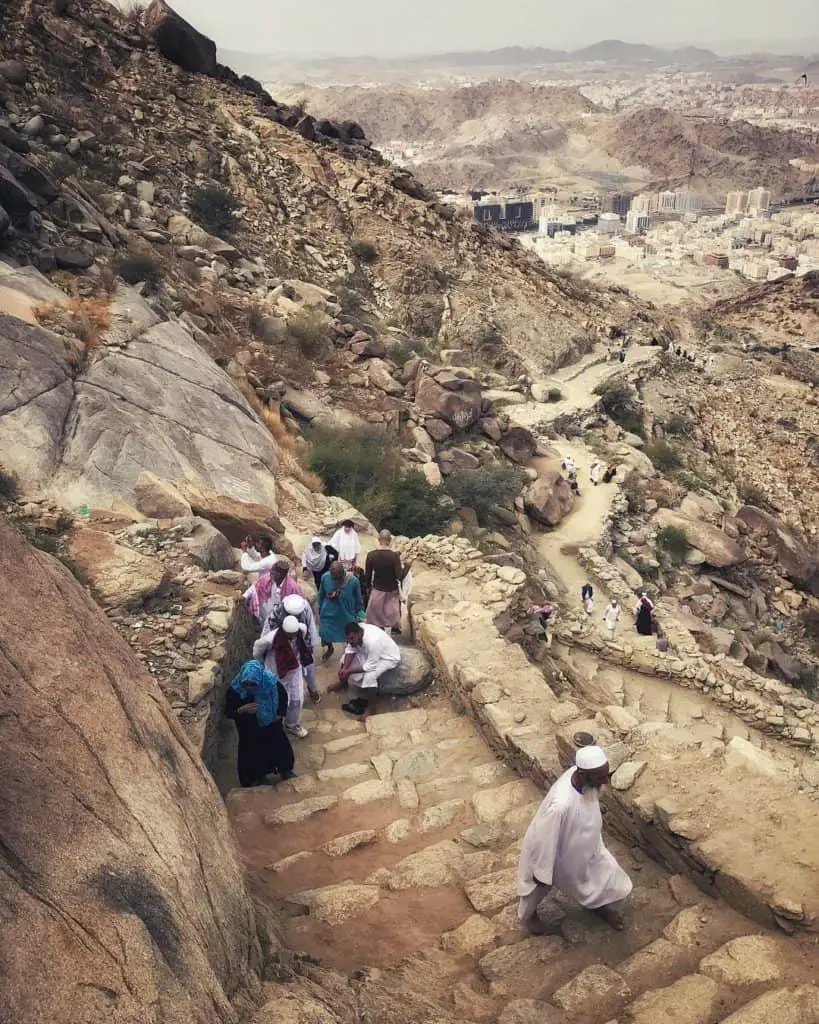
It is difficult to climb Jabal Thawr. Today. A road and car park have been built to accommodate visitors closer to the cave.
The cave itself is small, about 4 meters deep and 2.5 meters wide. It is just over 2 meters in height.
It is about 12km in the south of Mecca in the area of Misfalah and not well known nor visited very often by pilgrims due to its distance.
How to Get to Jabal Thawr
Take a taxi. Low season will cost SR 30-50 one way. Anything more is too expensive. Don’t let yourself be ripped off.
Click to read about sources and the story of the Cave of Thawr.
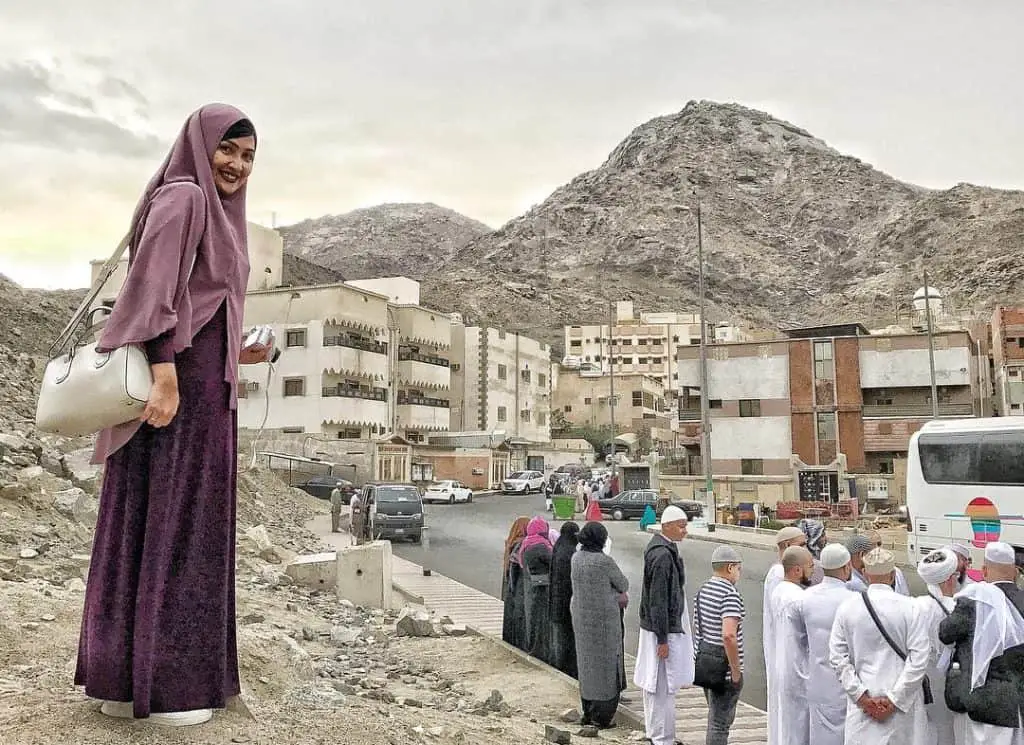
Fun Fact
500 years ago, the entrance and pathway to the Cave of Thawr were widened for visitor ease.
Visiting The Old Ajyad Fortress
Since 1780, visitors admired the view of the beautiful Ajyad Fortress that perched up high on the top of the Bulbul mountain overlooking the Haram Mosque.
The Turkish styled citadel was built by the Ottoman authorities to protect the Kaaba and Masjid Al Haram from attackers and bandits.
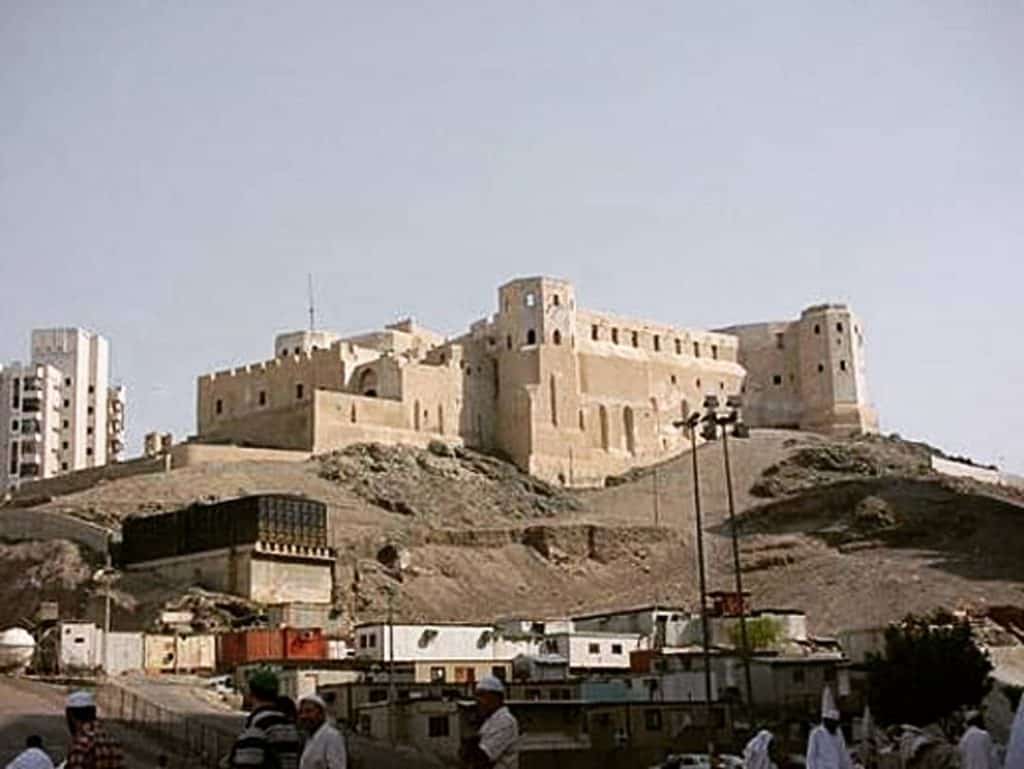
Unfortunately, in spite of the protests from Turkey the23,000m fortress was leveled in January 2002. The mountain on which it stood was removed and the $533 Abraj Bait Towers was built in its place.
Fun Fact
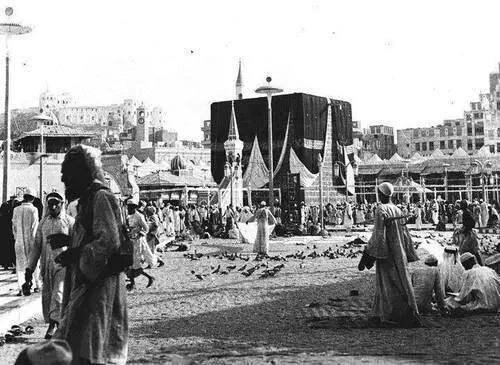
The Ottoman Turks ruled Saudi Hijaz for 400 years from 1518 until 1924. The fort overlooked the Kabaa for hundreds of years. Today, it is no longer there!
Visiting Abraj Al Beit Tower
This seven skyscraper complex called Abraj Al Beit hosts the Mecca clock tower. It stands right opposite the Grand Mosque directly opposite King Abdul Aziz Gate.
It has two large prayer rooms (men and women) that hold 10,000 people. It has a five-star hotel, a shopping Mall, and a 1000 car parking facility.
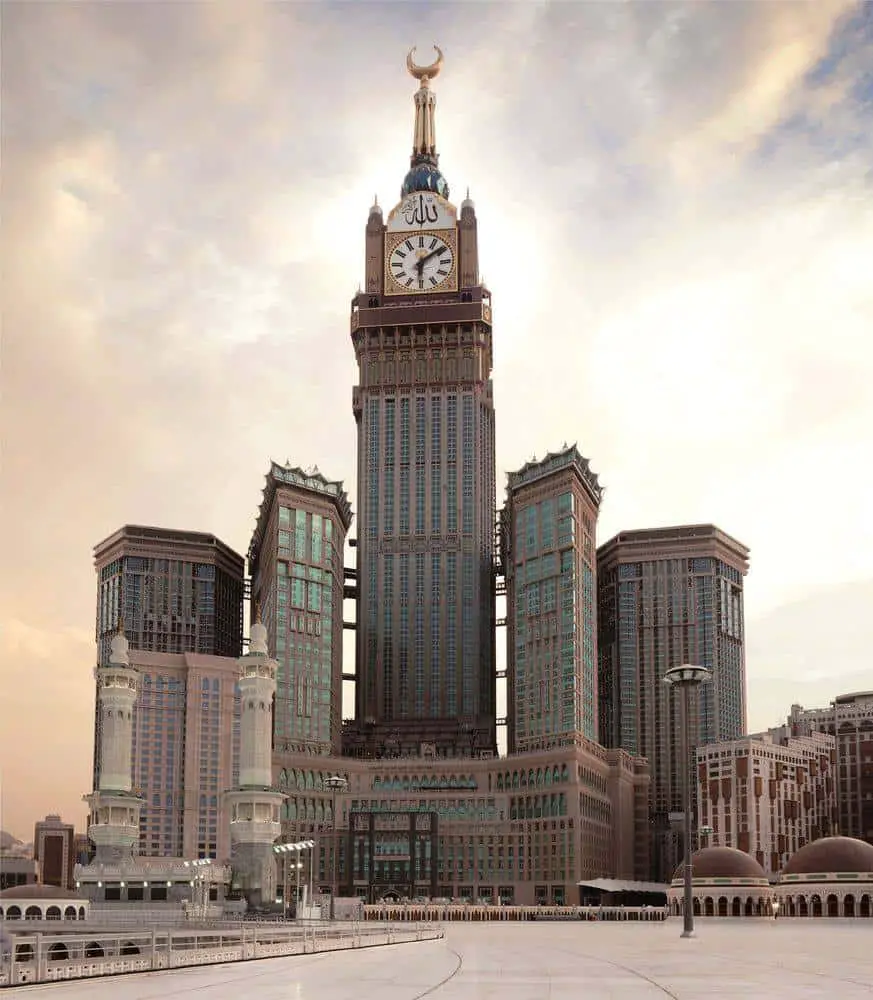
It is 601m or 1,972ft high. The seven towers are called:
- Makkah Royal Clock Tower
- Hajar
- Zam Zam
- Safa
- Marwa
- Al Maqam
- Qibla
Fun Fact
Abraj Al Beit Tower is the most expensive building in the world costing $15 billion and it is the fifth tallest building in the world.
Admiring The Mecca Clock
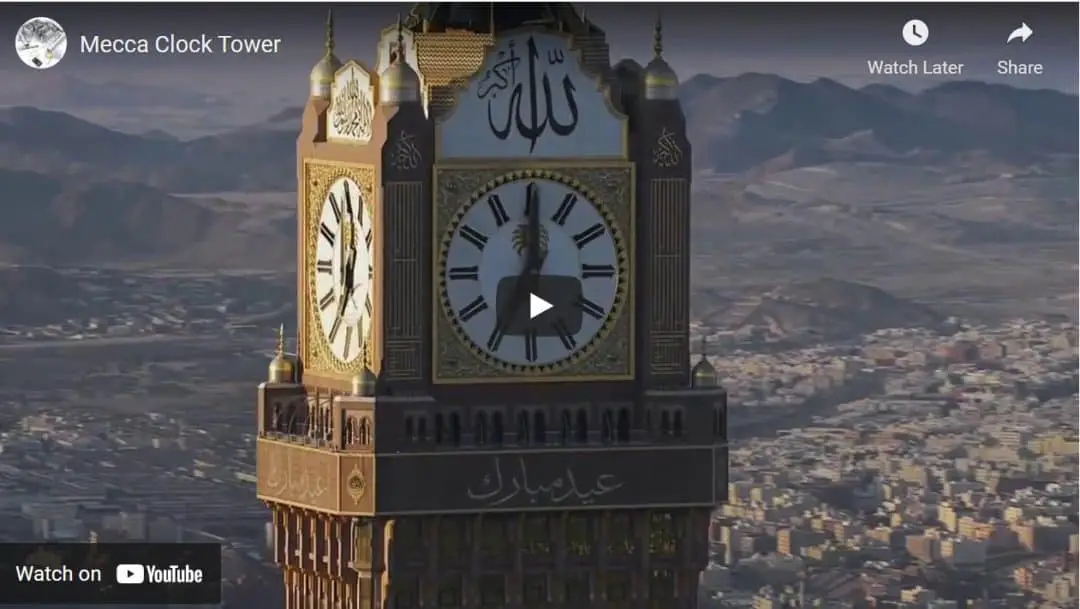
Click Here To See It On YouTube

The Mecca clock faces four directions and each face is 43m in diameter. They are illuminated by 2 million LED lights. Above the North and South faces there is an Arabic script that reads Allahu Akbar or God Is Great.
The four faces are covered with 98 million pieces of glass mosaics. The hour hand is 17m long and the minute hands are 23m long.
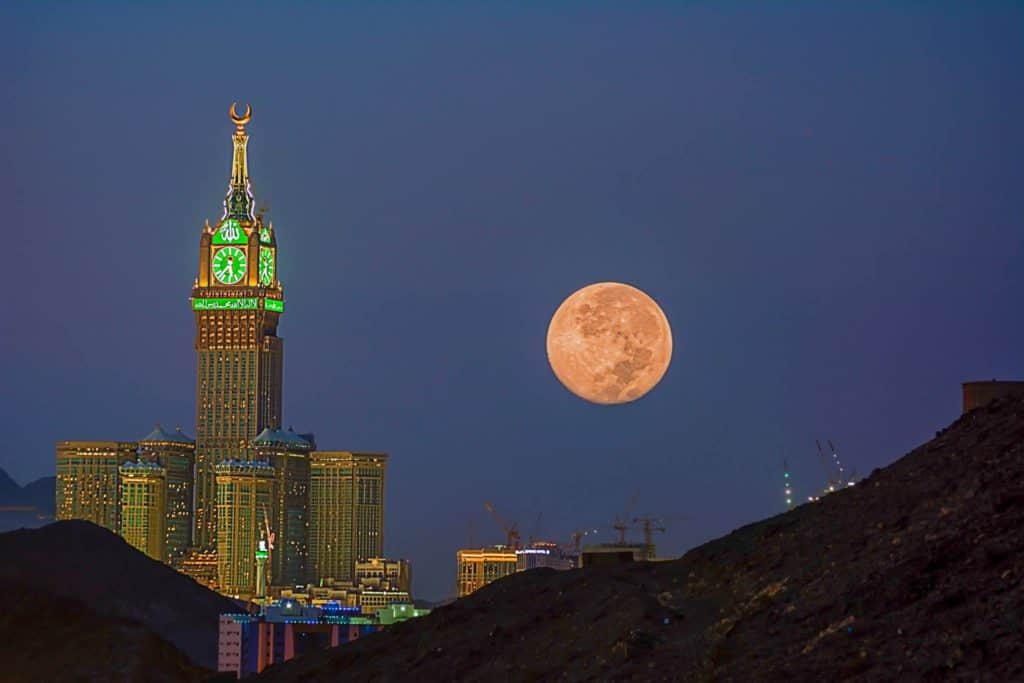
On the East and West faces the inscription reads the Islamic testimony of faith Leh Elaha Ee la Allah Mohammadan Rasool Allah, or There is no God but Allah and Mohammed Is His Messenger.
The spire is 128 m 420 ft and is eight stories and a base covered in glass.
The minaret has loudspeakers that broadcast prayer times up to 7km away.
Lighting Up Prayer Times
At prayer times, the clock lights flash green and white to indicate the prayer time using an additional 21,000 green and white lights. The lights let deaf or hard of hearing people know the prayer times.
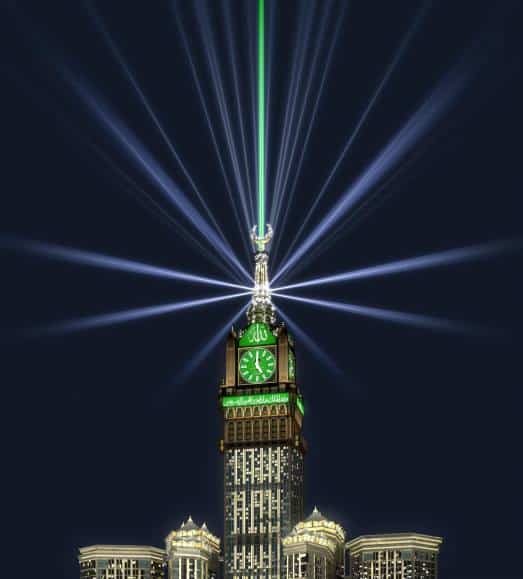
For special occasions, 16 bands of vertical laser lights shoot up vertically into the sky for Eid and New Year.
Going to the Top of the Mecca Clock
The top four floors of the clock tower host the Mecca Clock Tower Museum. It is a huge and very professionally made, interactive exhibition explaining how the universe was created and all about time.
It also shows in detail how the clock tower was built. It is fun and very informative.
The outdoor terrace at 558m or 1,831 ft high offers a magnificent view of Mecca and the Haram Mosque. Great sunset!
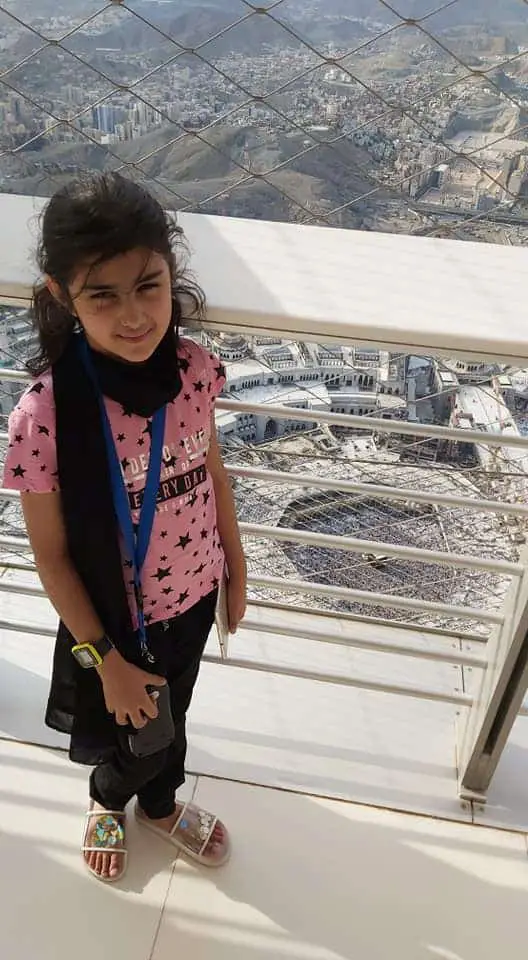
The cost of entry is SR150 about $50 per person. It opens 1-6 pm & 10-2 am Sunday to Saturday
Fun Fact
The Mecca clock is the largest clock face in the world and can be seen from a distance of 30km away, and the call to prayer (Adhan) can be heard 7km away.
To read more about the Abraj Al Beit click on the following Wikipedia link Abraj Al Beit.
Visiting the Zam Zam Water Bottling Plant, Kudai
Each day, 1.5 million liters of Zam Zam water is pumped out from the well along specially laid pipelines to the King Abdullah Bin Abdul Aziz bottling plant in Kudai district.
Also, a public fountain area called ‘Sabeel’ was built in Kudai. Here, people bring and fill up their own large plastic containers out of fast-flowing taps and hoses before taking their Zam Zam water home.
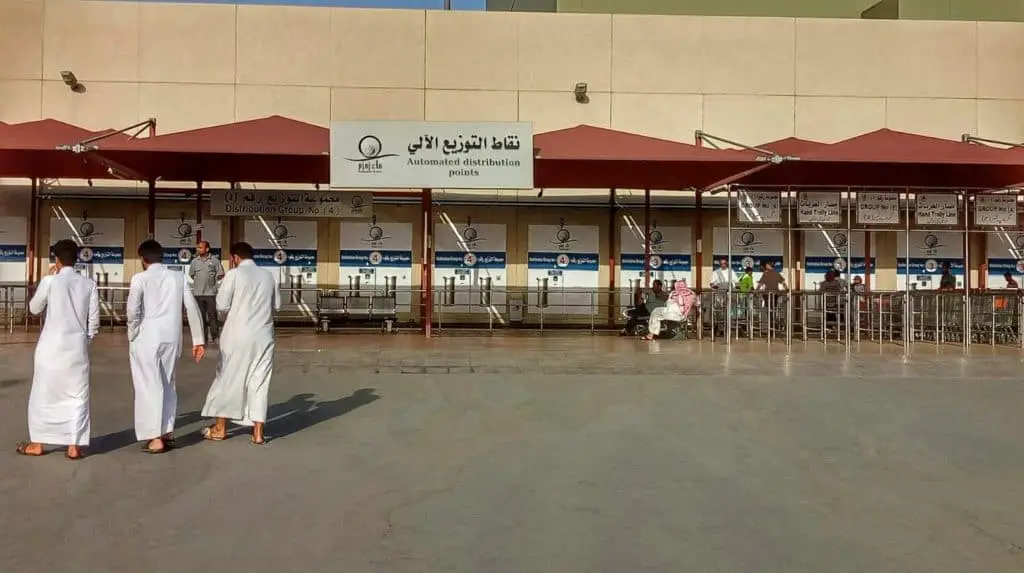
At the Kudai plant, filling the large 5 and 10-liter plastic, sealed bottles are now automated in ultra-hygienic conditions and these bottles are stored in a central warehouse.
A massive 1.5 million of 10-liter bottles are filled and stored in the huge warehouse each day. It is easy for the general public to buy the Zam Zam water at the Kudai plant.
Barcode readers scan customer purchase vouchers and the bottles of Zam Zam water are dispensed automatically and made available to them at the collection points for transport.
Fun Fact

Every day, 1.5 million liters of Zam Zam Water are being pumped a distance of 4.5 km to the Kudai bottling plant.
Main Activities For Muslim Pilgrims In Madinah Can Include:
Praying at Masjid Al Nabawi
After completing Hajj or Umrah, Muslim pilgrims love to visit the city of Madinah to pray at Masjid Al Nabawi, or the Prophet Mohammed’s Mosque.
The heavy work of building the original mosque was done by Prophet Mohammed (SAW) himself and his companions Sahaaba in the first year of Hijrah 622 CE.
Prophet Mohammed (SAW) bought the land for the mosque from Sahal and Suhayl and it took seven months to build.
It measured 30.5m X 25.62 m. The roof was made of palm tree leaves and clay and was supported by palm tree trunks.
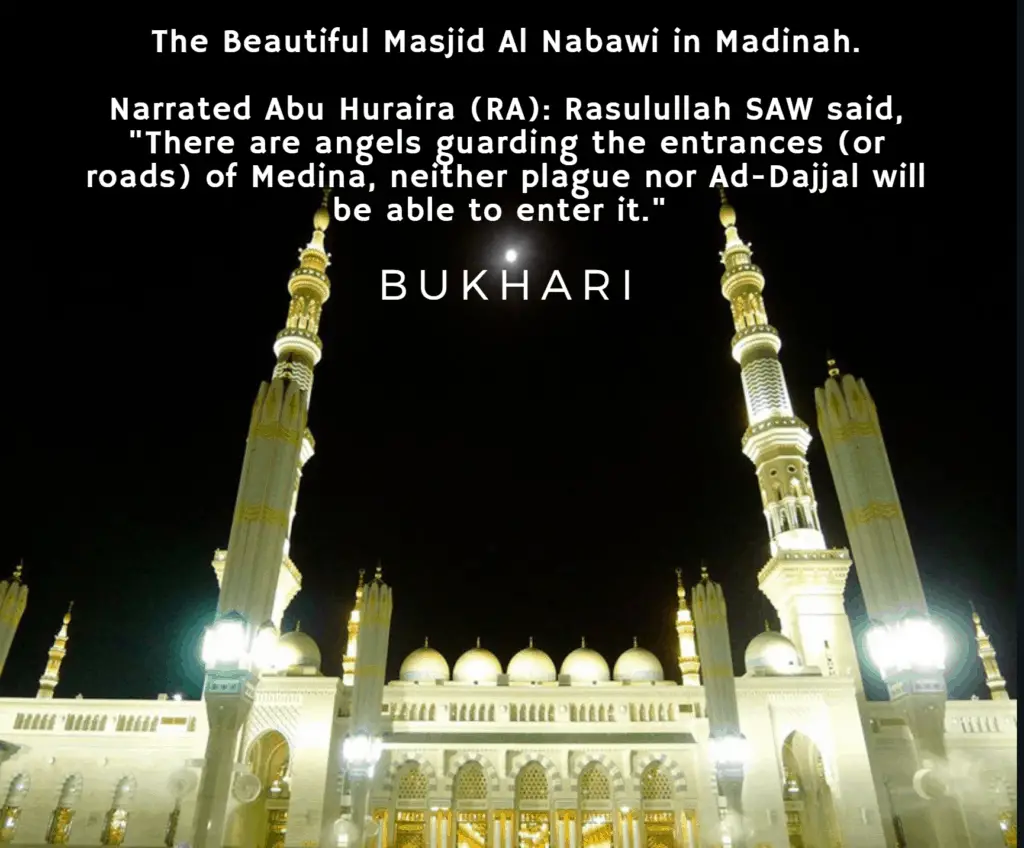
Three doors existed at that time:
- South Door: Baba Al Rahman
- West Door: Bab Al Jibreel
- East Door: Bab An Nisa
In Prophet Mohammed’s time, it served as an open-air mosque, a meeting place, a courthouse, and a school of Islam and for learning the Holy Quran.
The mosque was expanded by the Caliphs Umar and Uthman 649 CE, Walid Abd Al Malek 707, Al Mahdi, 775-785 CE, Mahmud 11 in 1817 CE, Abdul Majid 1, and by successive Saudi kings till the present day.
It is located at the center of Madina city surrounded by hotels, markets and Malls. For the love of Prophet Mohammed (SAW), Muslim pilgrims love to visit this mosque and for the blessings it bestows.
Under the green dome circa 1817 CE, originally the house of Aisah (RA) and rebuilt many times over the centuries, is the tomb of Prophet Mohammed (SAW), Abu Bakr (RA) and Umar Ibn Al Khattab (RA).
Another grave is reserved for Isa, Jesus (AS) as it is believed that one day he will return to Madinah and be buried there.
Masjid Al Nabawi is rectangular in shape with a flat-topped roof. It has 27 domes that slide open to allow light into the mosque.
The paved courtyard outside is used for prayers and is shaded using giant umbrellas that open on hot days and close in the cold weather.
You can get to the roof by stairs or by automatic lifts.
Rawdah As Shareef- Gardens of Paradise
An area inside the mosque between the minbar and the tomb of Prophet Mohammed (SAW) is called Al Rawdah which means the Garden of Paradise (Al Jannah).
It is understood to be the Riyadh Al Jannah or Gardens of Paradise. It is carpeted green to distinguish the area from the rest of the red-carpeted mosque.
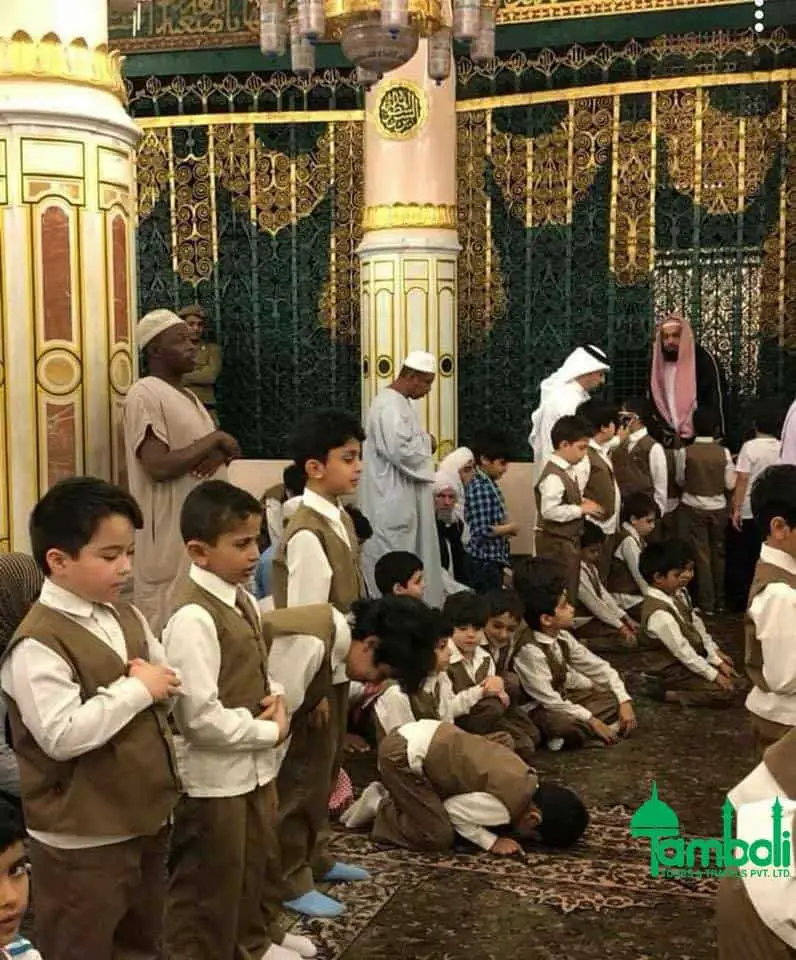
Two Mihrabs
There are two Mihrabs in the Prophet’s Mosque, one built by the Prophet himself (Mihrab Al Nabawi) and another by Caliph Uthman.
There are also niches called Mihrab Fatima and Mihrab Tahajjud also built by Prophet Mohammed (SAW).
Five Minbars Made Since The Time of Prophet Mohammed (SAW)
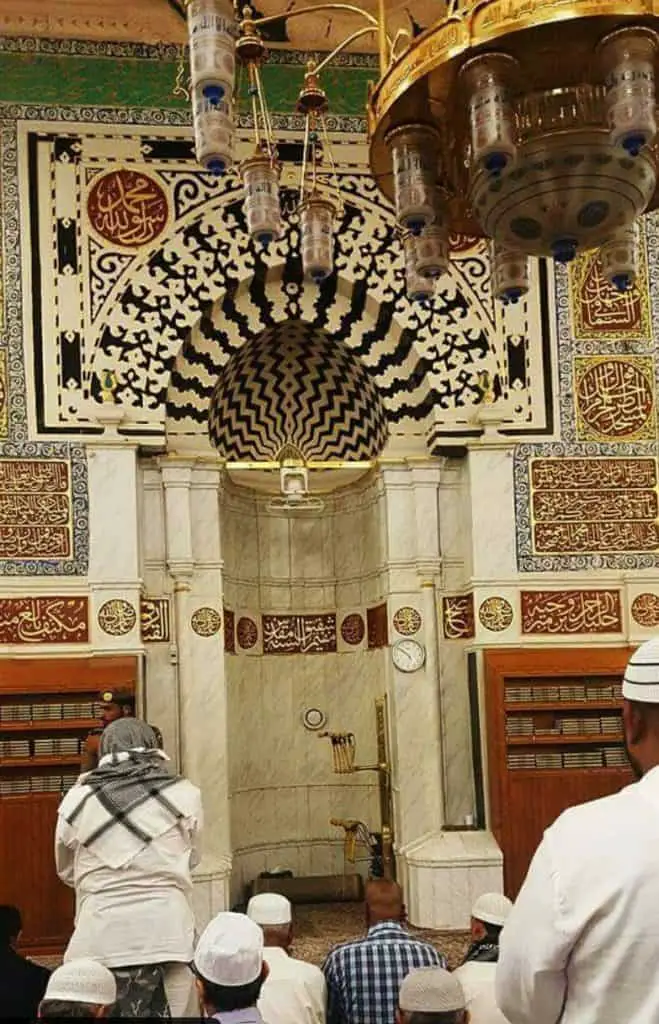
The present-day Minbar or platform used for delivering sermons (Khutbah) was built in the 15th century by Shaykh Al Mahmudi in 1417. The Baybars 1 replaced the one originally used by the three rightly guided Caliphs Abu Bakr, Umar, and Uthman i 1395.
Prophet Mohammed (SAW) delivered Khutbahs and spoke to the people on a wooden block made of a date tree and later one made out of tamarisk.
Minarets
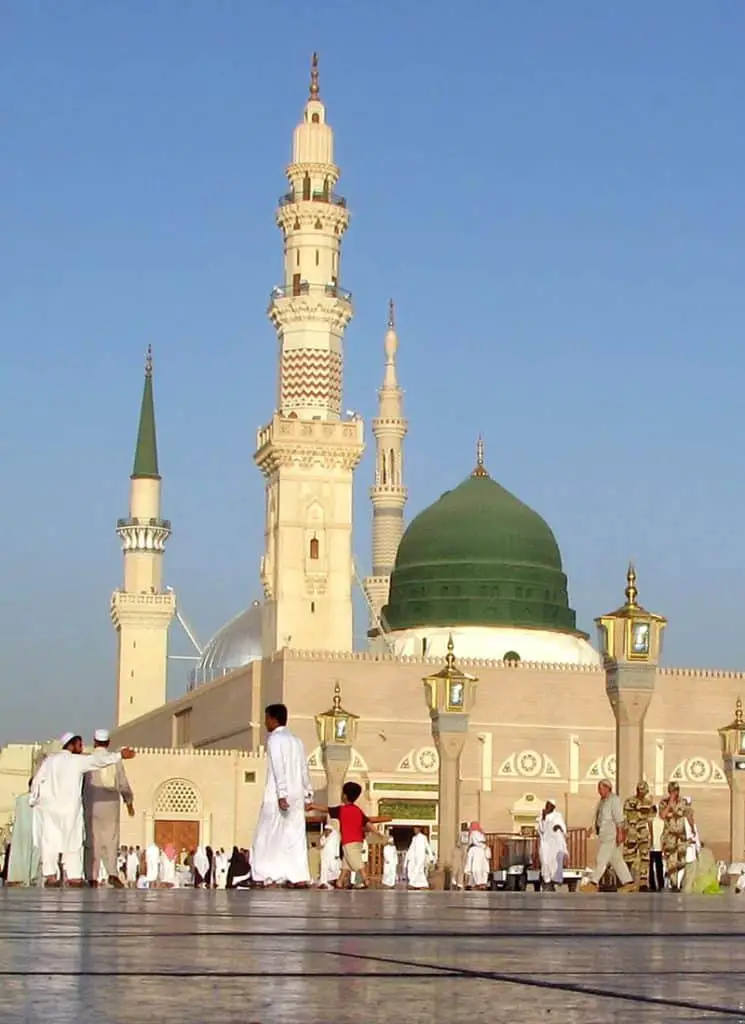
Originally, four minarets were built by the Caliph Umar (RA). Bab Al Salam minaret was added in 1307 by Muhammed Ibn Kalvavun.
The renovation in 1994 included an extra ten minarets that stand 104 meters high.
Fun Fact
Muslims believe that prayers (Dua) offered in the Prophet’s Mosque Masjid Al Nabawi are always answered.
Praying at Quba Mosque
The Quba Mosque is the oldest mosque and contemporary to Prophet Mohammed (SAW). The Prophet (SAW) laid the mosque’s foundation stone and spent 14 days praying short prayers (Salat Al Qasr) in the mosque.
It is also where the first Friday prayer, (Salat Al Jummah) was held.
The Quba Mosque is located 6km away from Madinah city in the district of Quba. It was rebuilt from scratch in 1986 with 7 main entrances, 4 minarets, 56 domes, a marbled courtyard, and a white marbled Minbar and Mihrab.
The prayer area centers around a central open courtyard. Three porticos (bays) border the courtyard.
Originally, Prophet Mohammed (SAW) laid the foundation stone of the Quba Mosque as soon as he arrived in Madinah following his migration from Mecca (Hijrah 622 CE). The companions finished building it.
Fun Fact
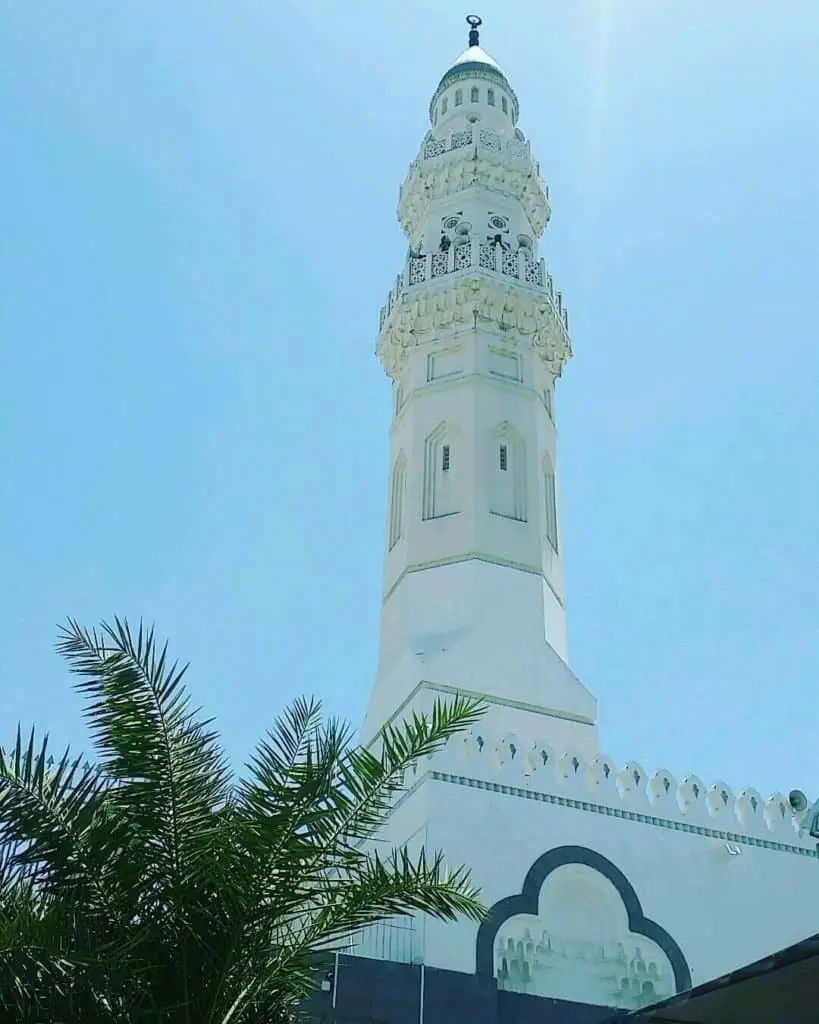
Every Saturday, Prophet Mohammed prayed two raqaat prayers in the Quba mosque.
Praying at Qiblatain Mosque
The Qiblatayn Mosque has Mihrabs or two Qibla; one current for Mecca and one out of use for the Al Aqsa Mosque in Jerusalem.
The early Muslims used to pray in the direction of Jerusalem.
However, one day in Madinah, whilst standing for noon prayers (Al Duhur) facing Al Aqsa Mosque in Jerusalem, Prophet Mohammed (SAW) received a revelation from Allah (SWT) commanding him and all Muslims to turn towards Masjid Al Haram in Mecca for the prayers.
‘We have certainly seen the turning of your face, [O Muhammad], toward heaven, and We will surely turn you to a qiblah with which you will be pleased. So turn your face toward al-Masjid al-Haram. And wherever you [believers] are, turn your faces toward it [in prayer]. Indeed, those who have been given the Scripture well know that it is the truth from their Lord. And Allah is not unaware of what they do.
Click to hear the above verse in Arabic from The Holy Quran, Surah Al Baqarah Verse 144
The change to the second direction of prayer Qibla occurred just under two years after Prophet Mohammed (SWT) and the companions’ famous migration (623/624 CE) to the old city of Yathrib, now called Madinah Al Munawara.
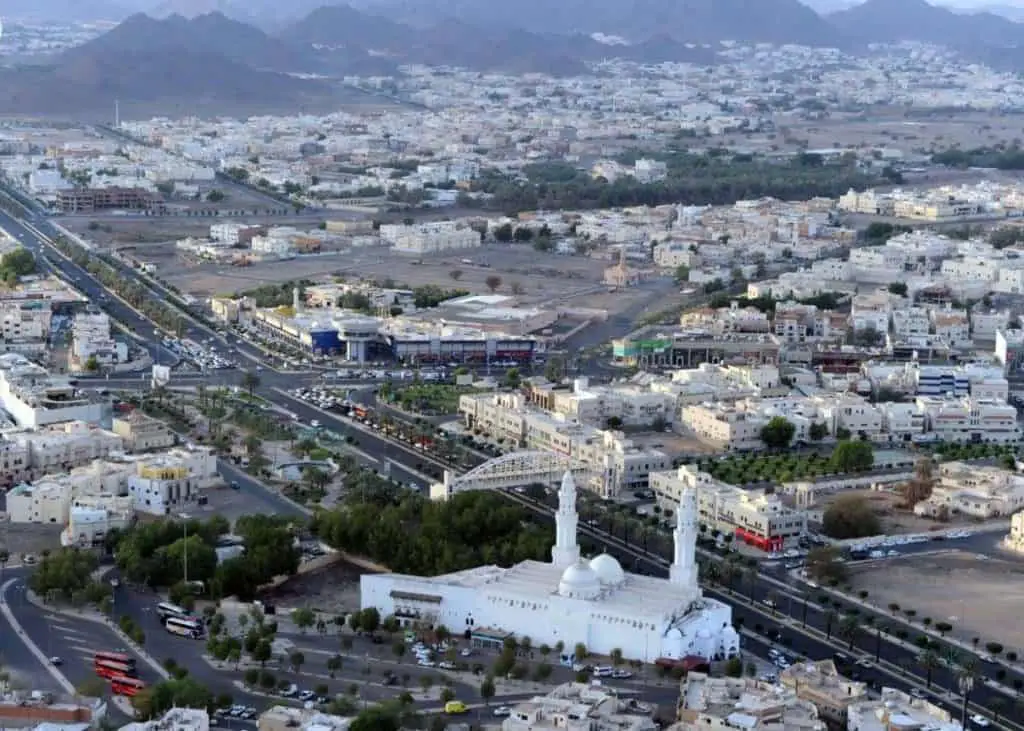
Even until today, you can find two mihrabs there, a kind of semicircular niche in the interior mosque wall offering the direction of prayer and from which the Imam (priest) stands in front of the praying congregation.
One mihrab points towards Masjid Al Aqsa and the other towards the Kaaba in Mecca.
The Quba Mosque is located in North West Madinah on King Khalid road. It has two minarets and two domes.
The praying area is raised above the ground floor. There is an underground washing area. (Wudhu) and steps to the courtyard leading to the prayer hall.
Fun Fact
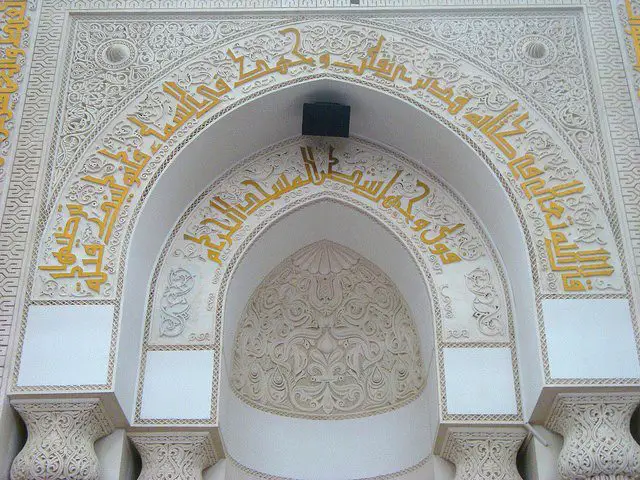
Below the false dome in the interior, there is a Mihrab that is an exact copy of a Mihrab in the lower chamber of Masjid Al Aqsa.
Jannat Al Baqi
The Garden of Baqi (Jannat Al Baqi) was the first cemetery in Madinah where family, friends of Prophet Mohammed (SAW) and Caliphs were buried.
It is a large open area located next to the Masjid Al Nabawi in the South East area of the mosque. You can easily access it from the large outside courtyard covered with collapsible umbrellas.
It is also known as Baqi Al Gharqad after the name of the spiny shrub (Boxthorn) that covered the ground before the graveyard was established.
Prophet Mohammed (SAW) chose the area of land for the cemetery to be built on after one of his companions called Esaad Bn Zurarah died. He was the first to be buried there.
The second was Ruqayah (RA) his daughter in 624. The third was Uthman Bin Maz’oon a companion who had emigrated (Hijrah) with Prophet Mohammed from Mecca to Madinah in 627. His son was buried there too.
Caliph Uthman Bin Affan had been buried in the Jewish cemetery. Muawiyiah 1, Caliph 30 years after the death of Prophet Mohammed (SAW) extended the Jannat Al Baqi to include the Jewish cemetery in honor of Uthman Bin Affan.
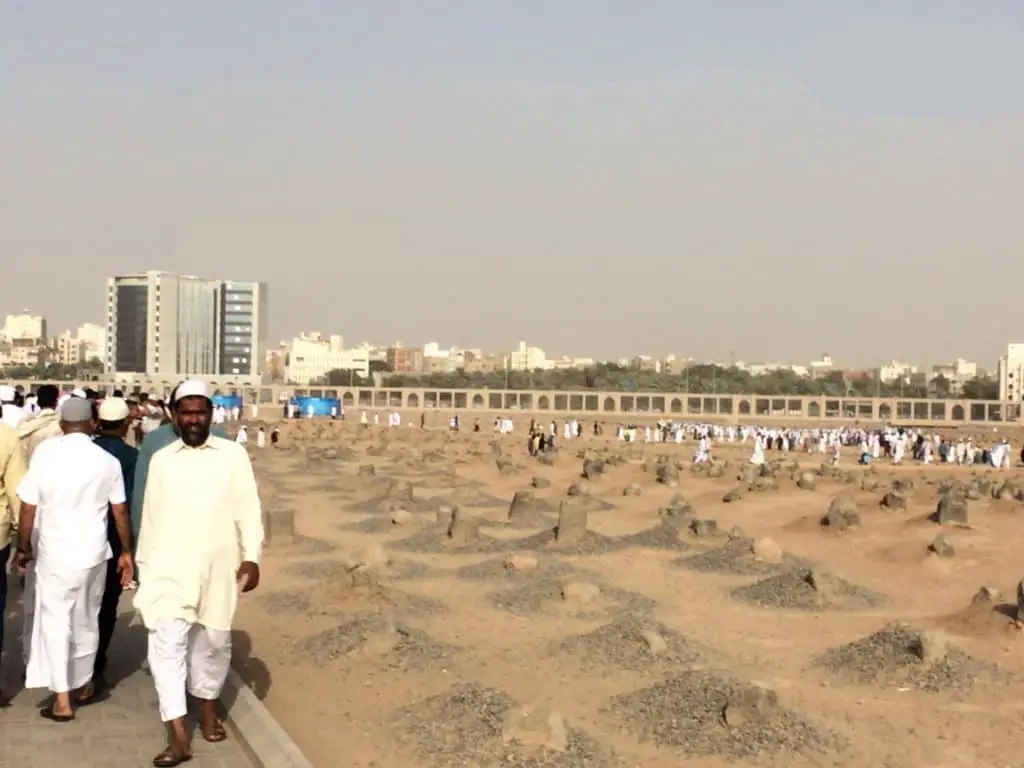
Here is a list of the members of Prophet Mohammed’s (SAW) family who were interred at the Jannat Al Baqi.
| No | Name | Relationship To Prophet Mohammed (SAW) |
| 1 | Halimah | Wet nurse To Mohammed (SAW) as a baby. |
| 2 | All Wives | Except for Khadijah Bint Khuwaylid and Maymunah Bint Al Harith |
| 3 | Ibrahim | Baby Son of his wife Maria Al Qibtiyya 630 CE |
| 4 | Ruqayah | Daughter 624 CE (Aged 23) wife to Uthman Bin Affan |
| 5 | Umm Kulthum | Daughter 630 CE (Aged 27) |
| 6 | Zainab | Daughter 629 CE ( Aged 30) |
| 7 | Fatima | Daughter 632 CE Mother to Hasan Bin Ali (Aged 22) |
| 8 | Fatima Bint Al Asad | Aunt & Mother to son and Caliph Ali 626 CE (Aged 76) |
| 9 | Abbas Ibn Abd Al Muttalib | Uncle 653 CE (Aged 85) |
| 10 | Umm Al Banin | His Son Ali’s wife after his daughter Fatima died 684 CE |
| 11 | Safiyah | Aunt 634 or 644 CE (Aged 65) Disputed |
| 12 | Atika | Aunt 620 + CE |
| 13 | Hasan Ibn Ali | Grandson 5th Caliph 670 CE (Aged 45) |
| 14 | Ali Ibn Zayn Al AbidinAl Sajjad | Grandson 4th imam of Twelver and 3rd of Ismaili 713 CE (Aged 54) |
| 15 | Muhammad Bin Ali Bin Al Husayn Bin Ali Bin Ali Talib Al BaqirAl Ja’far | Son of Ali Ibn Husayn Fifth Imam of Twelvers and 4th Imam of Ismaili 733 CE (Aged 56) |
| 16 | Ja’far Ibn Muhammad As Sadiq | Son of Muhammed Al Baqir -6th Imam of Twelvers and IsmailiGrandson to Prophet Mohammed (SAW) four-times removed 765 CE (Aged 63) |
| 17 | Abdullah Ibn Al Ja’far | Nephew of Ali Ibn Talib 699 (Aged 75) |
| 18 | Aqeel Ibn Ali TalibAbu Aqaeel/Yazid | Cousin 673 Ce (Aged 96) |
| 19 | Uthman Bin Affan | Cousin & son in law 656 (Aged 77) |
| 20 | Uthman Bin Madh’oon | Companion 630 CE |
Fun Fact
Ja’dat Bin Al Ash’at Yemeni from the tribe of Kindah, poisoned her husband Hasan Ibn Ali Prophet Mohammed’s grandson who died two months later. Not so fun, really!
How To Get to Jannat Al Baqi
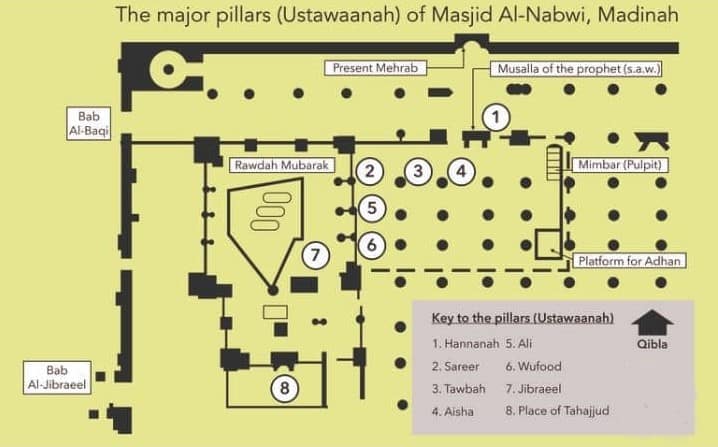
On exiting Masjid Al Nabawi head southeast through the gate called Bab Al Baqi or Al Baqi Gate or another called Bab Al Jibreel (AS), Jibreel Gate. Look ahead and you will see a raised boundary wall. This is the boundary to Jannat Al Baqi.
Go up the steps that lead to the cemetery. Only men are allowed to approach the cemetery wall. Women make their salams to the interred outside the wall.
The graveyard is very wide, open and well kept. The graves are unmarked and covered only with soil. There are no buildings or Mauseluems covering the graves. Burial areas have pathways and in ways.
There is no indication of who is buried where because all the graves are unmarked.
Visiting the Site of The Battle of Badr Al Khudra
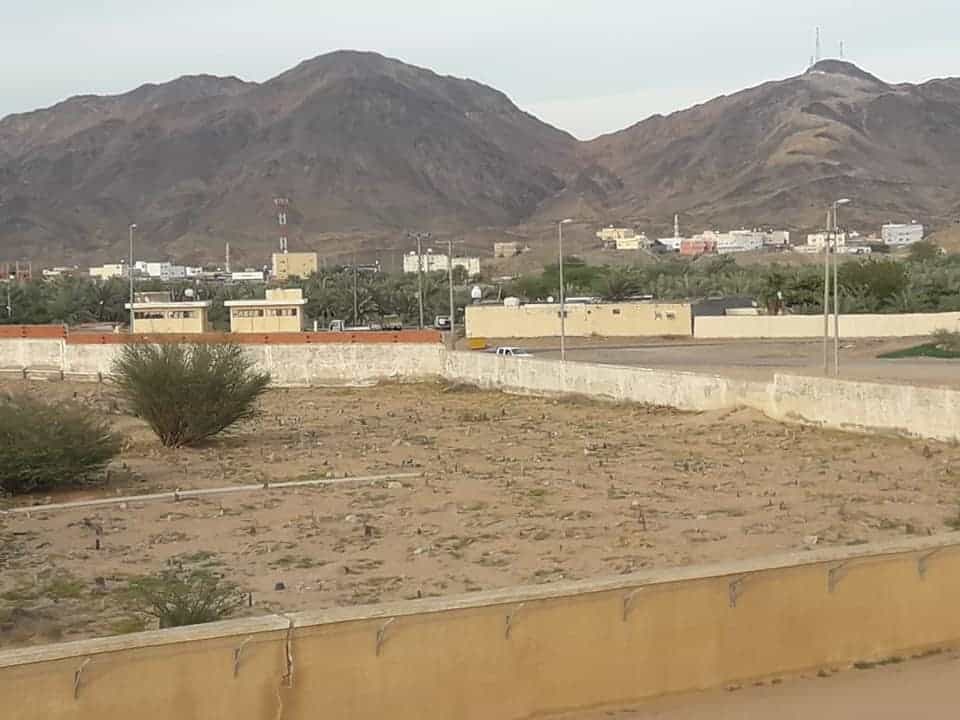
An excursion to Madinah for Muslim pilgrims should also include trips out to see the graves of the early Muslims who fought in the battles of Badr 624 CE and Uhud 624 CE.
Badr is between Mecca and Madinah. It is located 367km north of Mecca by road and 165km from Madinah city. Uhud is 5km due north on the outskirts of Madinah.
Badr was the first, decisive battle fought between the Quarashi pagans (Kuffar) and the Muslims from Madinah (Muhajirron and Ansar). There had been previous encounters between the two armies in localized skirmishes early in the year.
However, The Battle of Badr established Prophet Mohammed (SAW) and the Muslims as an important, new political force in Saudi Arabia of the time.
The background and details, plans and events of the battle are very interesting but too long to be dealt with here. To read in more detail about this amazing battle click to read the following Wikipedia article .
.
In brief, the Meccan polytheists wanted to use the battle to deal the last blow on Prophet Mohammed (SAW) and Muslims once and for all.
They spent the last 9 years oppressing, torturing and persecuting Muslims in Mecca until the Muslims were forced to emigrate (Hijrah) to Madinah known then as Yathrib in 622 CE.
The Qurahsi army brought 1,500 fighters to the battle from Mecca. However, disputes amongst the ranks later reduced them to 950. Abu Jahal was their leader. He viewed the Muslims as marauders.
In Mecca, they had seized the good and properties of the Muslim families. Because of this Muslims began raiding Meccan trade caravans heading back from Damascus which were also carrying weapons used to fight Muslims.
The ambushes were retribution for their horrific behaviour towards the new Muslims in Mecca between 613 and 622 CE.
Meanwhile in Madinah, Prophet Mohammed (SAW) mustered some 313 Muslims both from those who had originally migrated from Mecca together with converts from the local Ansar Muslims.
The Muslim army made camp at the Well of Badr and waited for the Quraishi army to arrive. Amongst them were Abu Bakr, Ali, Hamza, Mus’ab Ibn Umair, Az Zubair Bin Al Awaam, Ammar Bin Yasir, Abu Dhaar Al Ghifairi and Bilal.
The Qurayshi army made camp at the area of Jufah in the south of Badr. The 950 strong army included Qurayshi nobles and lords Amr Ibn Hisham, Walid Ibn Utbah, Umayyah Ibn Khalaf.
Their motives for the battles were to kill the Muslims for attacking their caravans, stealing their wealth and launching ambushes against them.
| Details | Prophet Mohammed (SAW) & Muslim Army | Abu Jahal & Qurayshi Army |
| Soldiers | 313 (6 with armour) | 950 with armour |
| Resources | Filled with faith, courage & certainty Controlled Water wells | Fearful, overwhelmed and weakened. No access to water wells. |
| Weapons | 8 Swords, Spears Bows/Arrows | 600 Swords |
| Camels | 70 | 700 |
| Horses | 2 | 300 |
| Losses | 14 (See names below) | 70 Dead 70 Captured 68 Converted to Islam |
The Badr Battle Events
The battle began on 13th March 624 CE with the two armies facing off next to the hill of Aqanqal in the Badr valley. The Quraysh leaders wanted three of their champion fighters to hand fight three Muslim fighters, but for politcal reasons refused to fight Ansar soldiers.
So 1. Hamza, 2. Ubaydah Ibn Al Harith and 3. Ali (RA all) came forward to fight for the Muhajiroun.
Hamza (RA) fought Utbah Ibn Rabi’ah and killed him. Ali (RA) fought and killed Walid Ibn Utbah. Ubaydah (RA) was wounded in his fight with Shaybah. Hamza (RA) and Ali (RA) then attacked and killed Shaybah. Ubaydah (RA) later died in Madinah.
The battle lasted a few hours. Untold numbers of Quraish soldiers were killed by arrows and in hand to hand combat. During the battle, Allah (SWT) sent 1,000 angels to attack and terrorize the Quraysh army.
Prophet Mohammed (SAW) blew dust off his hands that Allah used to cause blindness and confusion in the ranks of the Quraysh. The remaining terrified Qurashi soldiers retreated.
Allah (SWT) addressing Prophet Mohammed (SAW) mentions this fact and promises more divine help for Muslim steadfastness and courage.
Allah (SWT) exhorts Muslims to be strong and steadfast in battle and promises even more angels to help them in the following verse.
After the battle, 2 Quraysh prisoners were executed and their bodies dumped into disused wells along with the remainder of the 70 Qurayshi souls who lost their lives. On that day, 14 Muslims became martyred.
Today, their names are still listed on a tall commemorative stone at the Badr gravesite which can be visited today.
8 of them were Ansar and 6 were Mahajiroon. One was a boy!
These are the names of the martyrs in the order that they appear on the tall stone at Badr:
| No | Name |
| 1. | Umayr bin Abi Waqqas al-Muhajiri |
| 2. | Safwan bin Wahb al-Muhajiri |
| 3. | Zish Shamalain ibn ‘Abdi ‘Amr al-MuhajiriBut called Dhou Shamalain |
| 4. | Mihja’ bin Salih al-Muhajiri |
| 5. | Aaqil bin al-Bukayr al-Muhajiri |
| 6. | Ubayda bin al-Harith al-Muhajiri |
| 7. | Sa’d bin Khaythama al-Awsi |
| 8. | Mubashir bin ‘Abdi’l Mundhir al-Awsi |
| 9. | Haritha bin Suraqa al-Khazraji |
| 10. | Rafi’ bin al-Mu’alla al-Khazraji |
| 11. | Umayr bin al-Humam al-Khazraji |
| 12. | Yazid bin al-Harith bin Fus.hum al-Khazraji |
| 13. | Mu’awwidh bin al-Harith al-Khazraji (A boy) Click here to read his story from Sahihayn Al Bukhairi |
| 14. | Awf bin al-Harith al-Khazraji |
Prophet Mohammed (SAW) and the Muslims stayed at Badr for a further three days just in case the Quraish army decided to continue the battle. However, they did not return. The Muslims then returned to Madinah with their captives.
They demanded ransoms for the return of the hostages to Mecca including teaching illiterate Muslims how to read.
68 hostages later converted to Islam and spoke well of the good treatment they had received by the Muslims.
The Quraish who had vehemently opposed Prophet Mohammed (SAW) later converted to Islam in large numbers in 1830 after his return to Mecca.
How To Get To Badr
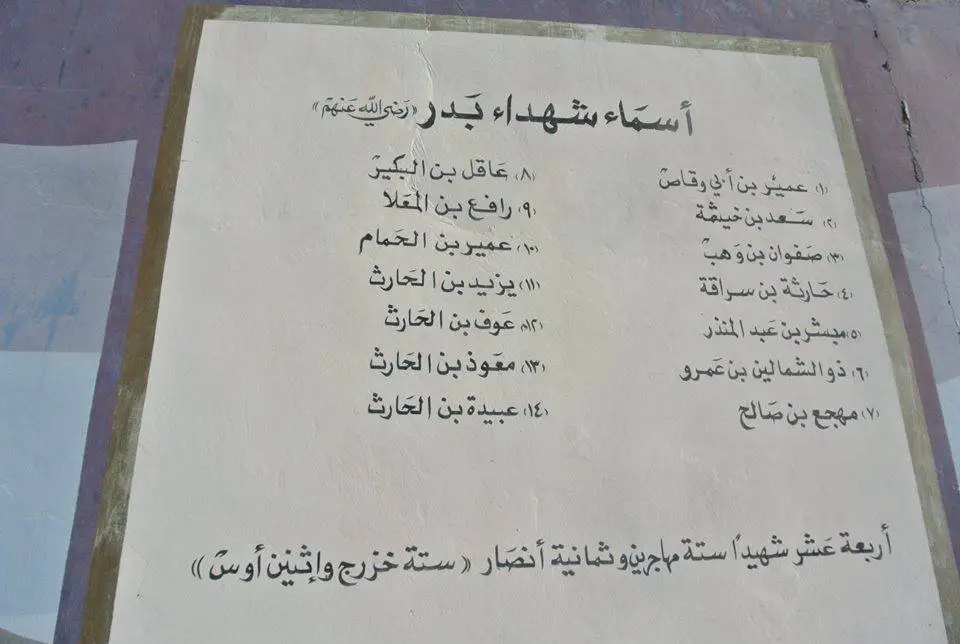
The small town of Badr is 167 km south of Madina and 350 km north of Madina close to the Red Sea. For the exact location see the video of Badr.
Fun Fact
8 of the Badr matyrs were Ansar and 6 were Muhajiroon. One was a boy!
The names of all the fighters at Badr can be read here in the following Wikipedia article.
The Battle of Uhud
December 624 CE
The battle fought at the foot of Mount Uhud in the north of Madinah was intended as revenge on the Muslims for the humiliating defeat of the Quraysh pagans at Badr earlier that year in March 624 CE.
With so many Quraysh leaders dead, this new campaign was led by Abu Sufyan, by Hind the daughter of Utbah slain at Badr, Ikrimah son of Abu Jahal (Left flank) who was also slaughtered at Badr, Amr Bin ‘As (Cavalry Commander) and Khalid Bin Walid (Right flank).
They camped on the green areas of northern Madinah to wait for the Muslims to come out to meet them.
Inside Madinah, the Muslims debated whether to meet the Quraysh inside the city itself or to engage them outside.
Fearing destruction to crops, farms and livelihoods, they decided to meet them outside the city.
Leaders of the Muslims from Madinah included Prophet Mohammed (SAW), Ali Ibn Al Talib, Hamza his uncle, Musab Ibn Umayr, Abdullah Ibn Jubayr, Mundhir Ibn Amr, Za Zubair Ibn Al Awwam and Ubadah Ibn Al Samit.
| Detail | Prophet Mohammed (SAW) & Muslims Army | Abu Sufyan and Quraish Army |
| Soldiers | 1000 Then, later only 700 50 Archers | 3,000 |
| Resources | Mount Uhud Archers’ Hill | Women chanting bashing timbrels (tambourines) and singing |
| Weapons | Stones/Spears/Swords | Armour/ Spears/Swords |
| Camels | 0 | 3,000 |
| Horses | 4 | 200 |
| Losses | 85 | 35 |
The Uhud Battle- Events
The Muslim force of 1000 was heavily outnumbered, but they gained the advantage early on by first encircling the Quraysh army and positioning themselves high up on Uhud’s lower slopes.
Just before the fighting, in a dispute, Abd Allah Ibn Ubay (from Khazraj tribe) withdrew 300 troops and went back to Medinah reducing the Muslim army to just 700.
Prophet Mohammed (SAW) placed 50 archers on a rocky mount in order to protect the one flank of the outnumbered Muslim troops to the West while the other flank was protected by Mount Uhud itself to the East of their camp.
He ordered them to NEVER leave their posts under any circumstances.
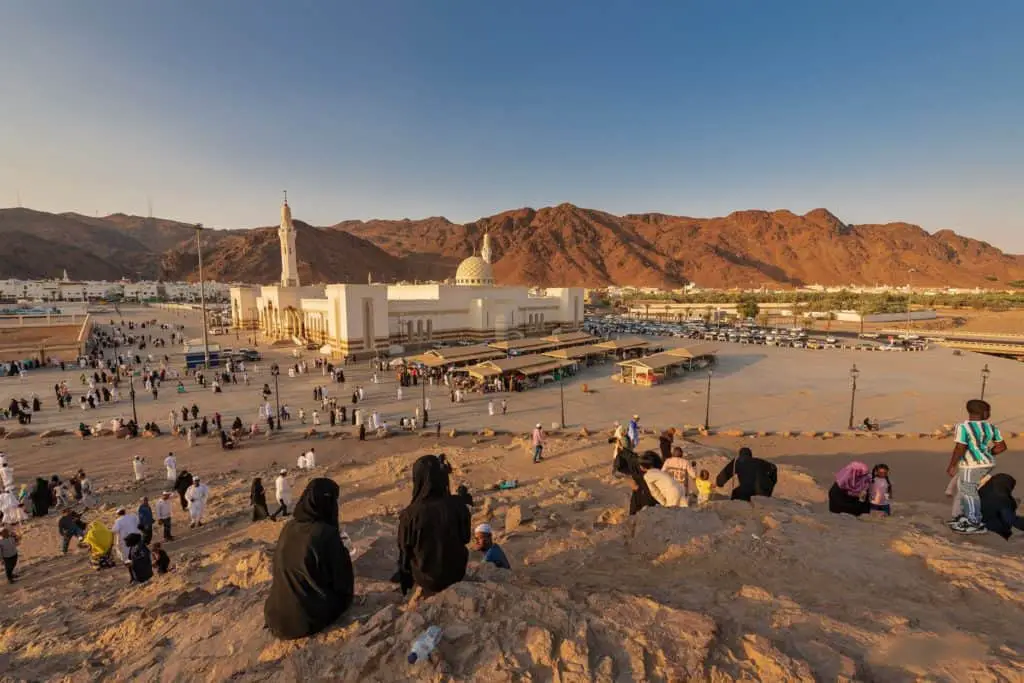
Prophet Mohammed (SAW) ordered a team of 50 archers to stay on the hill to a guard the rear flanked approach to the Muslim army.
Instead, most of the archers left their posts and ran into the camp with the main troops, leaving their encampment exposed.
All the Muslims believed that they had won the battle and ran em masses into the camp to claim booty and the spoils of war.
Seizing the opportunity Khalid Bin Waleed with 200 horsemen led a surprise attack from the rear and first attacked the remaning archers before finally overcoming the Muslim army.
Many got killed and the remainder of the Muslim army ran for the hills.
At Uhud, Muslims were defeated by the fact they had disobeyed Prophet Mohammed’s (SAW) orders out of greed for the spoils of war.
During the battle, Hamza (RA) the Prophet’s uncle was killed by the Ethiopian, Washi Bin Harb using a spear. He was ordered to do so by Hind Bint Utbah in revenge for Hamza having killed her father in Badr.
After the Muslim retreat, Hind opened Hamza’s (RA) belly, cut out his warm liver, ate it and used his body part to make bangles and jewelry.
Though the Muslims were completely defeated, the Quraysh failed to use their advantage of winning the battle to try to enter and to control Madinah.
Abu Sufyan turned his troops around and headed back to Mecca.
How To Get To The Uhud Battle Site
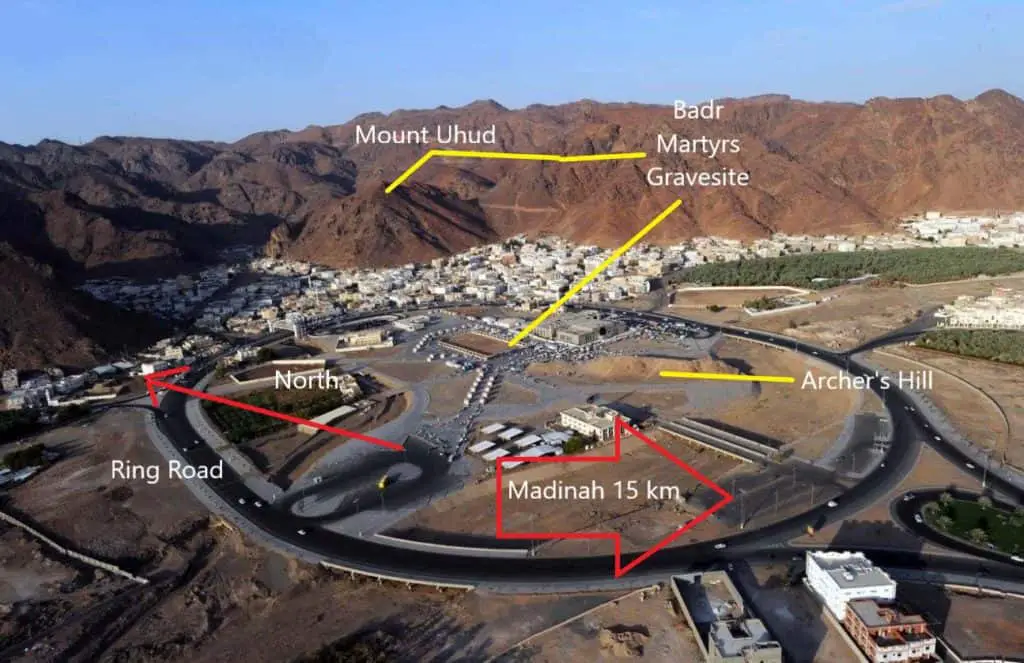
Today, you can visit the graves of the Muslim martyrs at Badr.
There is a walled gravesite, a large car park, outdoor market stalls, a mosque and you can actually go up and sit on Archer’s hill to take photos of Mount Uhud.
The Uhud battle site is only 15 kilometers north of the Masjid Al Nabawi.
You can find taxi drivers outside the Masjid Al Nabewi willing to take you to Uhud. It should not cost more than 15 SR.
They will also the Trenches Battle sites including Masjid Al Quba and Masjid Al Qiblatain for a flat fee of around 100 SR.
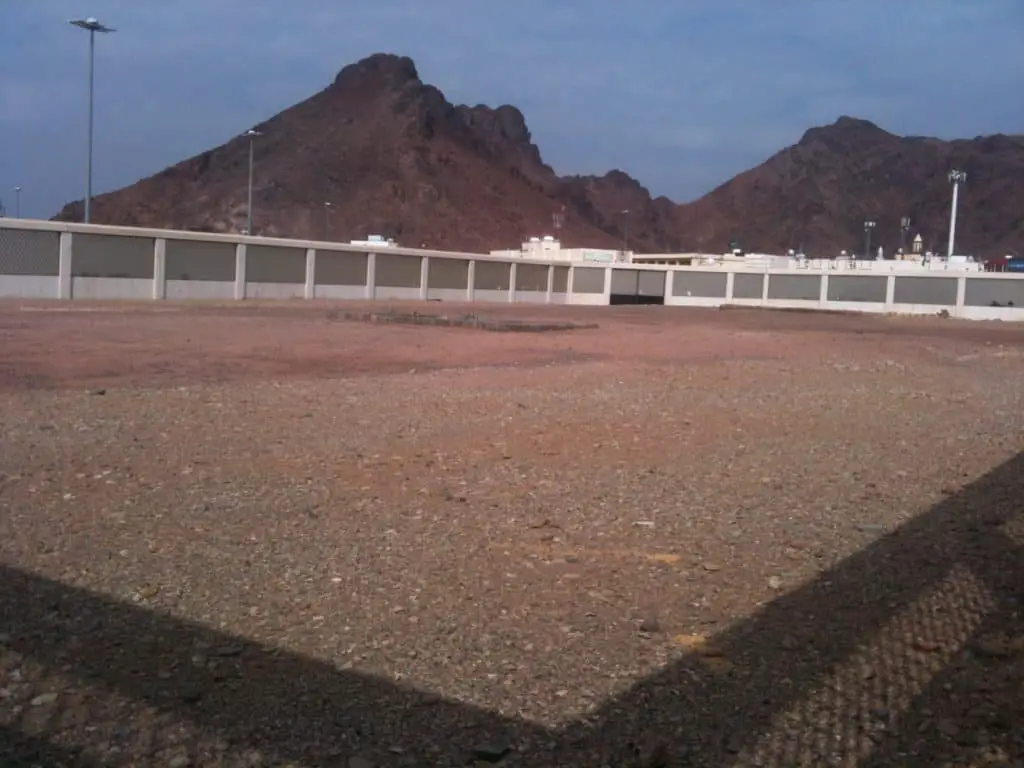
These are the names of the Muslim Martyrs who fell at Uhud
- Hamza ibn Abdul-Muttalib
- Anas bin an-Nadr al-Khazrajī
- Unays bin Qatādah bin Rabī‘ah al-Badrī al-Awsī
- Aws bin al-Arqam al-Khazrajī
- Aws bin Thābit bin al-Mundhir al-Badrī al-Khazrajī
- Iyās bin Aws al-Badrī al-Awsī
- Thābit bin ‘Amr bin Zayd al-Badrī al-Khazrajī
- Thābit bin Waqsh al-Awsī
- Tha‘labah bin Sa‘d al-Khazrajī
- Thaqf bin Farwah al-Khazrajī
- Al-Hārith bin Aws bin Mu‘ādh al-Badrī al-Awsī
- Al-Hārith bin‘Adī bin Kharashah al-Khazrajī
- Al-Hārith bin ‘Uqbah bin Qābūs al-Muhājirī
- Hubāb bin Qayzī al-Awsī
- Habīb bin Zayd bin Tamīm al-Awsī
- Husayl bin Jābir al-Awsī, Abū Hudhayfa al-Yamān (father of Hudhayfah ibn al-Yaman)
- Hanzala bin Abī ‘Āmir al-Awsī
- al-Hārith bin Anas bin Rāfi‘ al-Badrī al-Awsī
- Khārijah bin Zayd bin Abī Zuhayr al-Badrī al-Khazrajī
- Khidāsh bin Qatādah al-Badrī al-Awsī
- Khallād bin ‘Amr bin al-Jamūh al-Badrī, al-Khazrajī
- Khaythama bin al-Hārith al-Awsī
- Dhakwān bin ‘Abdi Qays al-Badrī al-Khazrajī
- Rāfi‘, mawla Ghaziyya bin ‘Amr al-Khazraj
- Rāfi‘ bin Mālik al-Badrī al-Khazrajī
- Rifā‘ah bin ‘Amr al-Badrī al-Khazrajī
- Rifā‘ah bin Waqsh al-Awsī
- Zayd bin Wadī‘ah al-Badrī al-Khazrajī
- Subay‘ bin Hātib al-Awsī
- Sa‘d al-Badrī, mawla Hātib bin Abī Balta‘ah al-Badrī al-Muhājirī
- Sa‘d bin ar-Rabī‘ bin ‘Amr al-Badrī al-Khazrajī
- Sa‘īd bin Suwayd al-Khazrajī
- Salamah bin Thābit bin Waqsh al-Badrī al-Awsī
- Sulaym bin al-Hārith al-Badrī al-Khazrajī
- Sulaym bin ‘Amr al-Badrī al-Khazrajī
- Sahl bin Rūmī al-Awsī
- Sahl bin ‘Adī bin Zayd al-Awsī
- Sahl bin Qays bin Abī Ka‘b al-Badrī al-Khazrajī
- Shammās bin ‘Uthmān al-Badrī al-Muhājirī
- Sayfī bin Qayzī al-Awsī
- Damrah bin ‘Amr al-Badrī al-Khazrajī
- Qurrah bin ‘Uqba al-Awsī
- Qays bin ‘Amr bin Zayd al-Badrī al-Khazrajī
- Qays bin Mukhallad al-Badrī al-Khazrajī
- Kaysān, mawla Banī ‘Adī bin an-Najjār al-Khazrajī
- ‘Āmir bin Umayya al-Badrī al-Khazrajī
- ‘Āmir bin Mukhallad al-Badrī al-Khazrajī
- ‘Āmir bin Yazīd bin as-Sakan al-Awsī
- ‘Abbād bin Sahl al-Awsī
- ‘Ubbād bin al-Khashkhāsh al-Badrī al-Khazrajī
- ‘Abbās bin ‘Ubāda al-Khazrajī
- ‘AbdAllāh bin Jubayr al-Badrī al-Awsī
- ‘AbdAllāh bin Jahsh al-Badrī al-Muhājirī
- ‘AbdAllāh bin Salamah al-Badrī al-Awsī
- ‘AbdAllāh bin ‘Amr al-Badrī al-Khazrajī (father of Jabir ibn Abd-Allah)
- ‘AbdAllāh bin ‘Amr bin Wahb al-Khazrajī
- ‘Ubayd bin at-Tayyihān al-Badrī al-Awsī
- ‘Ubayd bin al-Mu‘allā al-Khazrajī
- ‘Utbah bin Rabī‘ bin Rāfi‘ al-Khazrajī
- ‘Aqrabah al-Juhanī, Abū Bashīr al-Muhājirī
- Umārah bin Ziyād bin as-Sakan al-Badrī al-Awsī
- ‘Amr bin Thābit bin Waqsh al-Awsī
- ‘Amr bin al-Jamūh al-Badrī al-Khazrajī
- ‘Amr bin Qays bin Zayd al-Badrī al-Khazrajī
- ‘Amr bin Mutarrif al-Khazrajī
- ‘Amr bin Mu‘ādh al-Badrī al-Awsī
- ‘Antarah as-Sulamī al-Badrī, mawla Sulaym bin ‘Amr al-Badrī al-Khazrajī
- Mālik bin Iyās al-Khazrajī
- Mālik bin Khalaf al-Muhājirī
- Mālik bin Sinān al-Khazrajī (father of Abu Sa’id al-Khudri)
- Mālik bin Numaylah al-Badrī al-Awsī
- Al-Mujadhdhar bin Ziyād al-Badrī al-Khazrajī
- Mus‘ab bin ‘Umayr al-Badrī al-Muhājirī
- Nu‘mān bin Khalaf al-Muhājirī
- Nu‘mān bin ‘Abdi ‘Amr al-Badrī al-Khazrajī
- Nu‘mān bin Mālik al-Badrī al-Khazrajī
- Nawfal bin ‘Abdillāh al-Badrī al-Khazrajī
- Wahb bin Qābūs al-Muhājirī
- Yazīd bin Hātib al-Awsī
- Yazīd bin as-Sakan al-Badrī al-Awsī
- Yasār, mawla Abi’l Haytham bin at-Tayyihān al-Awsī
- Abū Ayman, mawla of ‘Amr bin al-Jamūh al-Khazrajī
- Abū Habbah bin ‘Amr bin Thābit al-Badrī al-Awsī
- Abū Sufyān bin al-Hārith al-Awsī
- Abū Hubayrah bin al-Hārith al-Khazrajī
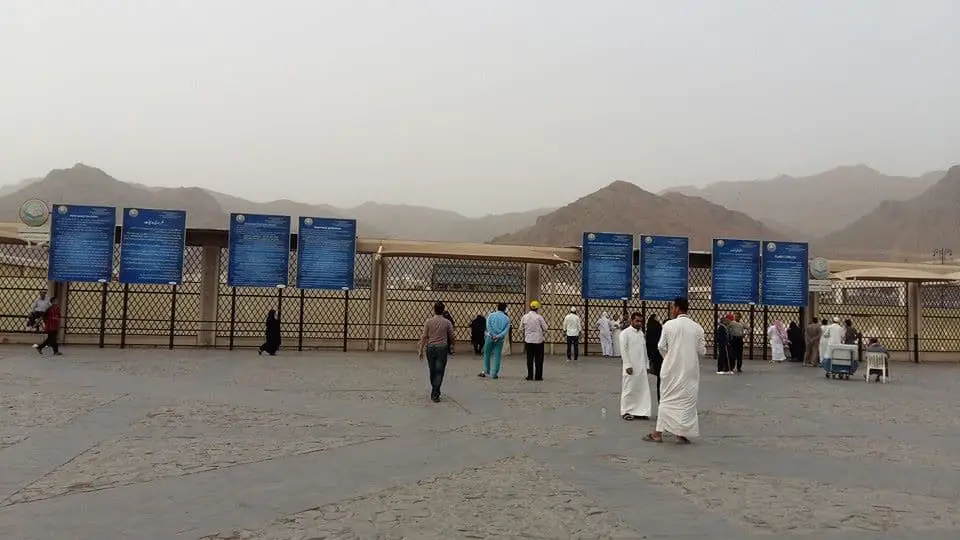
Fun Fact
- Medinah Martyrs: 75- Banu Khazraj 43 and Banu Awas 32
- Mecca Martyrs: 10
- 46 of them had fought at the Battle of Uhud.
Visiting The Site Of The Battle Of The Trenches (Khandaq)

On this site in 627 CE for nearly four weeks, 3,000 Muslim men from Madinah headed by Prophet Mohammed (SAW) held off an attack by a huge 10,000 men Quraysh army for a period of 27 days.
Led by Abu Sufyan, the army included men from the Quraysh, two Jewish tribes and more than six Arab tribes.
| Details | Prophet mohammed (SAW) | Abu Sufyan |
| Soldiers | 10,000 | 3,000 |
| Weapons | Stones/Spears/Swords | Armour/ Spears/Swords |
| Resources | Trench / Sala’ Hill | 600 Horses |
| Losses | 5 | 10 |
In order to keep 10,000 men from attacking Madinah, Prophet Mohammed (SAW) and the Muslims built a defensive trench so that the horses could not pass over and over which the soldiers could not traverse.
This was Salman Al Farsi’s idea.
The strategically placed trench was built in two weeks by all the men from Madinah over the age of 14. Crops that lay north of the trench were harvested early to stop the confederate army from feeding themselves and their horses.
The movement of enemy troops behind the trench was monitored from the peak of Mount Sala’ and any attempts to cross over it were met with volleys of arrows from the Muslims standing in line along the trench.
Food was scarce and the fighters went hungry. The nights were cold and they were very tired.
A group of Munafiks headed by Amr Bin Abd Wudd (equal to a thousand fighting men) broke through the defenses and challenged the Muslims to a hand to hand fight.
Out of fear, many Muslims refused to fight Amr Bin Abd Wudd except Ali Bin Abu Talib. He fought him bravely and in a cloud of dust killed the embattled Amr Bin Abd Wudd.
The death of the war hero confused the Quraysh army. Also, there were disagreements and instances of distrust between the tribes that caused them to fragment.
Add to that the bad weather (caused by Allah), cold and lack of food supplies and the invaders weakened greatly.
After 27 days and almost no advance the Quraysh gave up the attacks and returned to Mecca.
How To Get To The Trenches Battle Site
This ancient battlefield lies at the northern foot of the Sala’ mountain and is 1.5 km from Masjid Al Nabawi. It is exactly where the Muslim troops camped when facing the Quraysh kuffar.
You can easily walk or take a taxi to the site. There is nothing to be seen today except the so-called 7 mosques which in reality are only six, but can be seven of you include Masjid Al Qiblatain.
The largest, newest most beautiful mosque is called Masjid Al Khandaq. Five daily prayers are offered there including Friday and Eid prayers.
On the hill to the left of Masjid Al Khandaq is Masjid Al Fatah also known as:
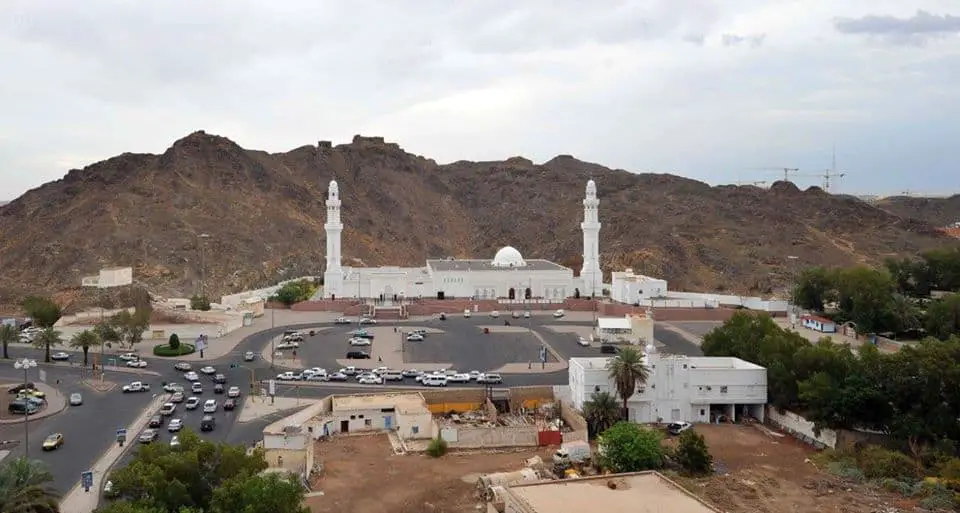
- Masjid Al Alaa
- Masjid Al Duaa
- Masjid Al Nabi
- Masjid Al Ahzab
The other remaining five, maybe six are small and are up to two hundred years old and some still exist today.
- Salman Al Farsi Mosque (Small building left of Masjid Al Khandaq )
- Abu Bakr As Siddique Mosque (Right of Masjid Al Khandaq up on the hill)
- Umar Ibn Al Khattab Mosque (Opposite Masjid Al Khandaq Car Park)
- Ali Bin Abi Talib Mosque (Opp Masjid Al Khandaq now demolished)
- Fatimah Al Zahra Mosque (Below Masjid Abu Bakr)
- Sa’ad bin Ma’az Mosque (Possibly existed and demolished)
Fun Fact
The main road in front of Al Khandaq mosque now covers where the trench (Khandaq) ran East to West.
How to Get To Madinah- Bus, Taxi, Train or Plane
I recommend you spend a few days or more in Madinah. Out of season, there are a lot of hotels and the prices are SR 200 plus per night and if you are single you can share rooms at a much lower cost.
You can get to Madinah by bus, taxi or train.
Bus
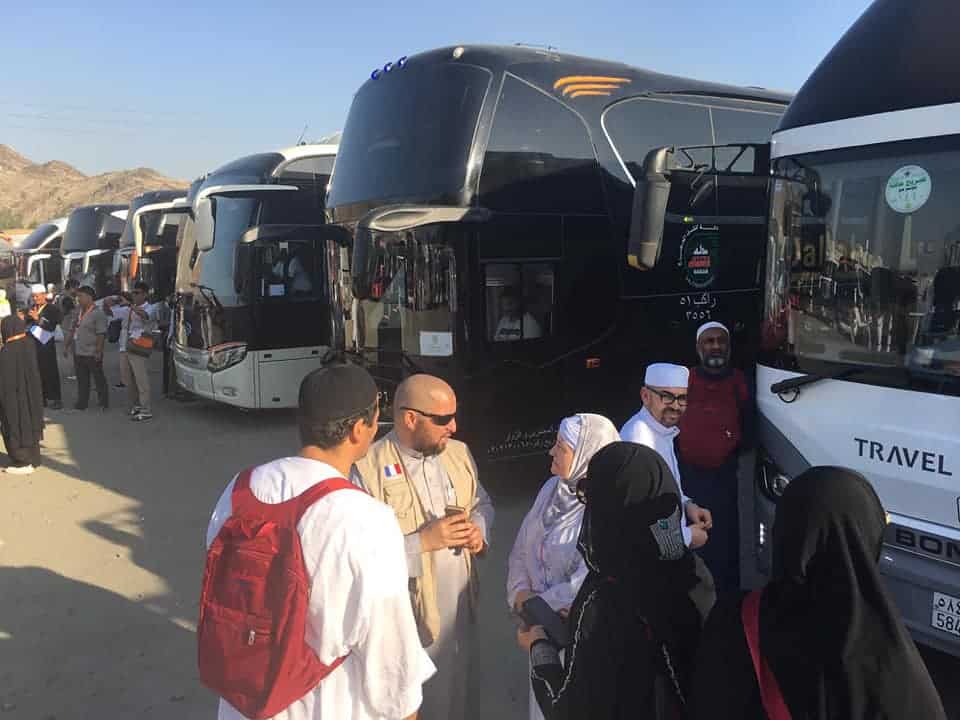
This is the slowest way and it takes about 5 hours. It costs SR 50-80 depending on the bus and the service.
Taxi
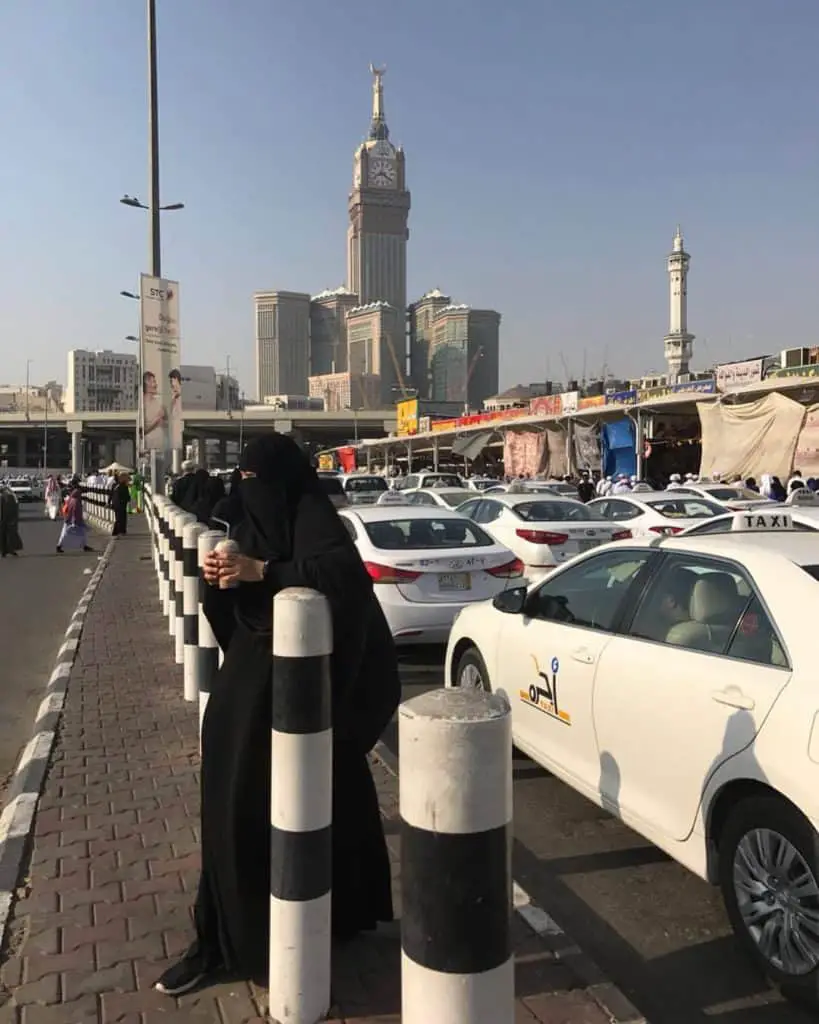
Taxis are faster, taking 4 hours. You pay SR 350-400 per taxi. They take you from door to door. Buses and Taxis are available at the ranks close to the Haram Mosque.
Kareem The Saudi Uber
Download The Kareem App and Take A Taxi From the Airport
Car Hire
You can hire cars in Jeddah for about 120-150 per day. You’ll need your home license and passport, plus a credit card. The problem though is where to park. Jeddah Airport recommended.
Train
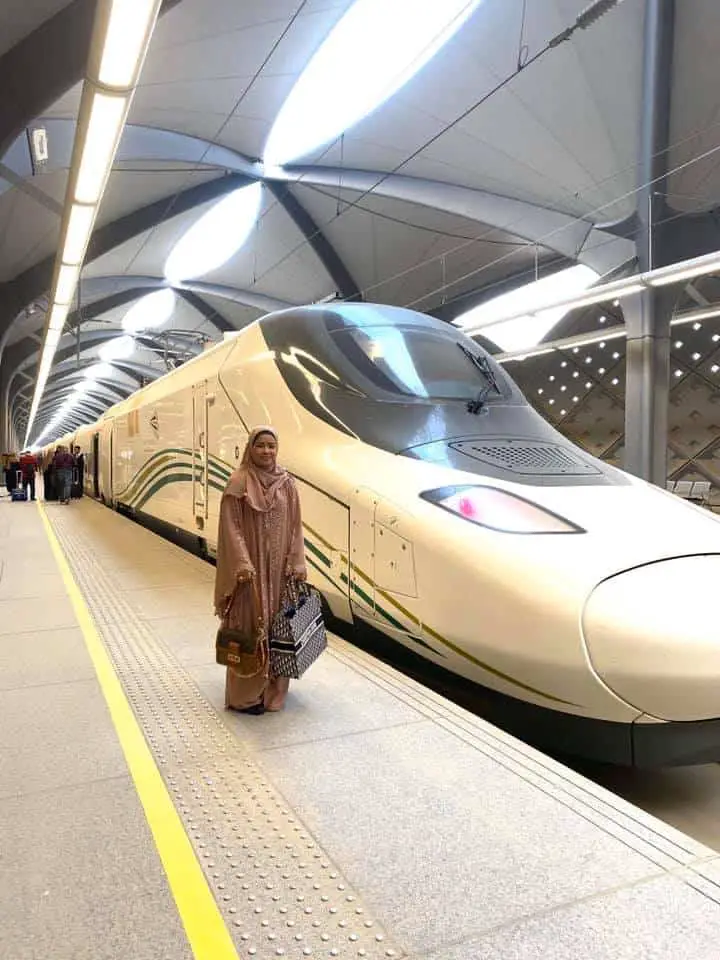
The New Haramain train service arrives in Madinah in under 3 hours. It costs SR 157 economy per person and SR 210 business class.
You are only allowed one piece of 25kg luggage and one piece of 7 kg hand luggage.
They are strict about luggage. If you have more than two pieces, you will need to send your bag by Saudi post. You will pay SR20 for a taxi to your hotel.
Book early on the website https://www.sar.com.sa/Home.aspx to avoid disappointment! Arrive at the station at least 30 minutes before you board. There will be a security check of luggage. Electric shavers etc are not allowed on board.
to avoid disappointment! Arrive at the station at least 30 minutes before you board. There will be a security check of luggage. Electric shavers etc are not allowed on board.
You can buy snacks and drinks on board. The seats are fairly comfortable and there is a high level of cleanliness and amenable customer service.
The trains stop at Mecca, King Abdulaziz International (New) Airport, King Abdullah Economic City of Rabigh and Madinah.
Other Useful Links And Resources
1 Medinah – Wikipedia
– Wikipedia
2. Mecca- Wikipedia
Wikipedia
3. Reward for Praying In Haram Mosques  – Islam Question and Answer
– Islam Question and Answer
4. Why Muslims Walk Around The Kabba -InsideSaudi.com
-InsideSaudi.com
5. Why Do Muslims Kiss The Black Stone -InsideSaudi.com
-InsideSaudi.com
6. 20 Compelling Reasons Why I Wont Drink Normal Water- InsideSaudi.com
InsideSaudi.com
7. Hajj- Wikipedia
Wikipedia
8. Safa and Marwa- Wikipedia
Wikipedia
9. Jabal Noor Reviews – Tripadvisor
– Tripadvisor
10. Jabal Noor  – Wikipedia
– Wikipedia
11. Jabal Thawr – Wikishia
– Wikishia
12. Jabal Thawr – Wikipedia
– Wikipedia
13. Historic Fortress Demolished- Arab News
Arab News
14. Ajyad Fortress – Wikipedia
– Wikipedia
15. Mecca’s Mega Architecture Casts Shadow-The Guardian
16. Abraj Al Beit- Wikipedia
Wikipedia
17. Mecca Clock Tower Museum- TripAdvisor
TripAdvisor
18. Kudai Zam Zam  Water-King AbdulAziz Zam Zam Water project
Water-King AbdulAziz Zam Zam Water project
19. Masjid Al Nabawi  -Wikipedia
-Wikipedia
20. The Quba Mosque- Wikipedia
Wikipedia
21. The Qiblatain Mosque -Wikipedia
-Wikipedia
22. Jannat Al Baqi -Wikipedia
-Wikipedia
23. The Battle Of Badr Happened In Ramadhan- Arab News
Arab News
24. The Site Of The Battle Of Badr- Islamic Landmarks
Islamic Landmarks
25. Battle Of Badr- Wikipedia
Wikipedia
26. Hamza Ibn Abdul Mutallib -Wikipedia
-Wikipedia
28. Mount Uhud (Medina) 2020 -All You Need To Know-Trip Advisor
-All You Need To Know-Trip Advisor
29. Mount Uhud -Wikipedia
-Wikipedia
30. The Battle Of Uhud- Wikipedia
Wikipedia
31. Full Story Of The Battle of the Trench Facts- The Islamic Information
The Islamic Information
32. Battle Of Khandaq -Wikishia
-Wikishia
33. Battle Of the Trench -Wikipedia
-Wikipedia
34. Haramain Fast Train Booking Site
Booking Site

